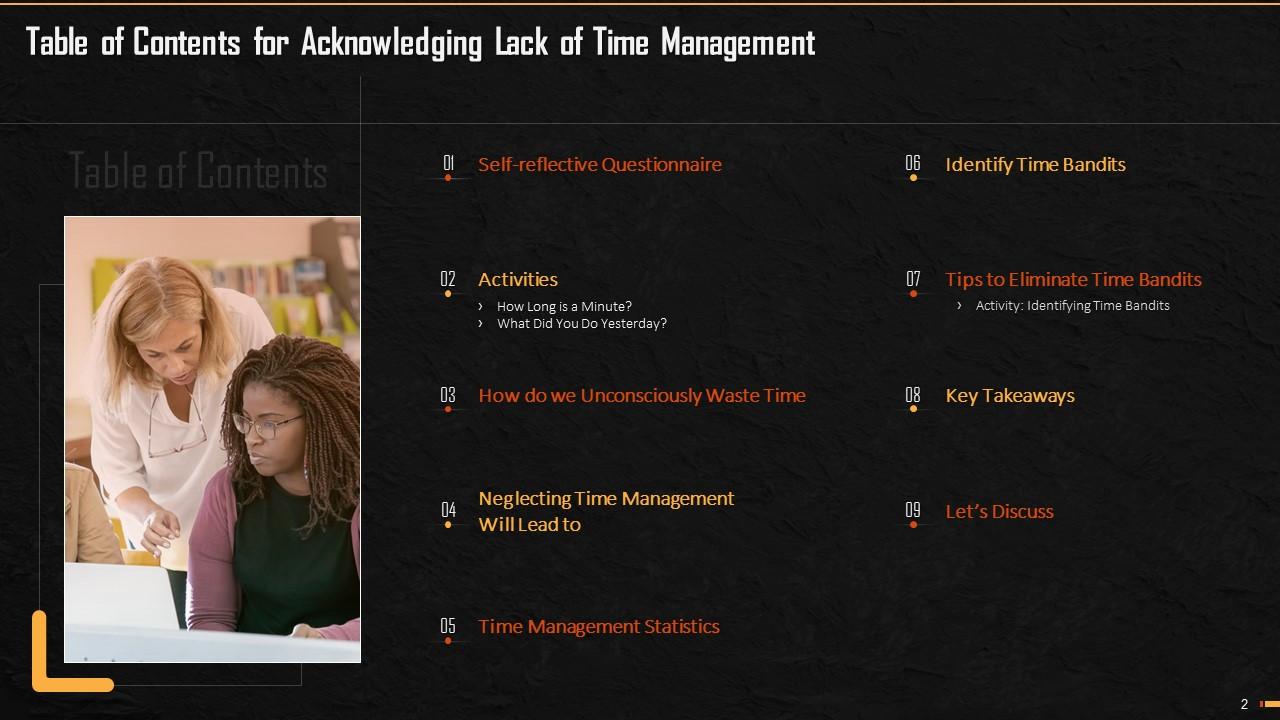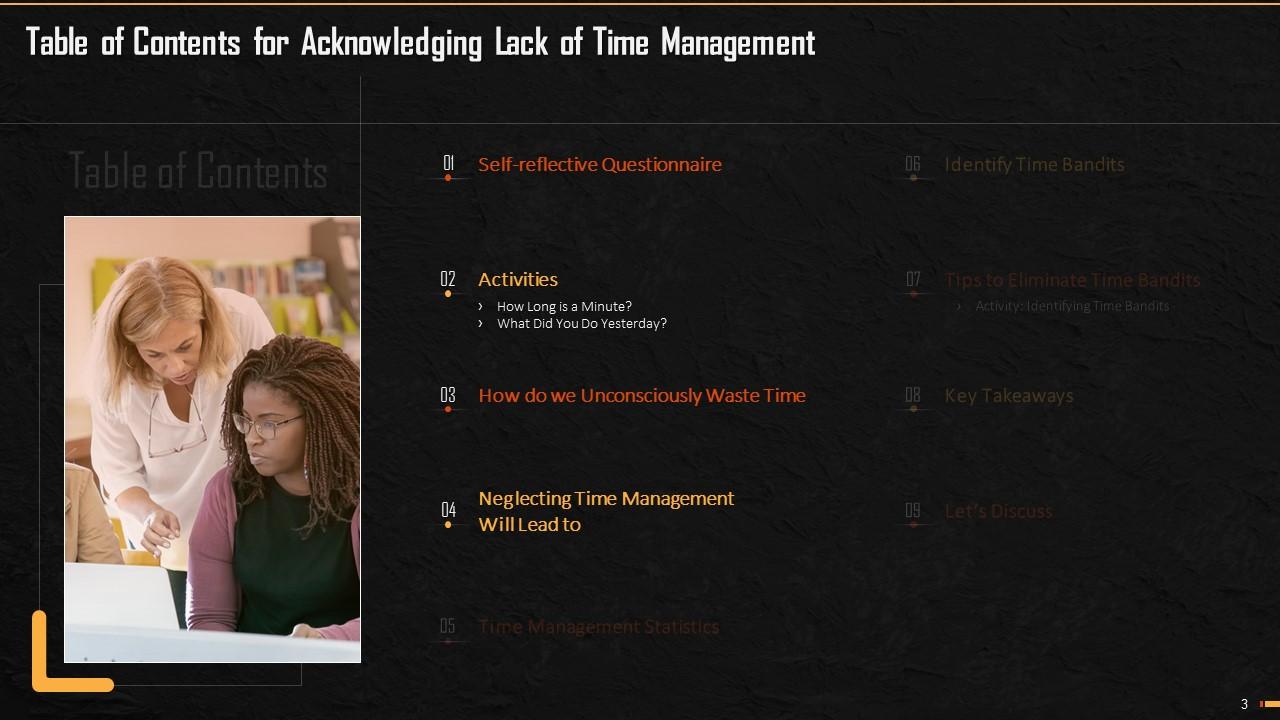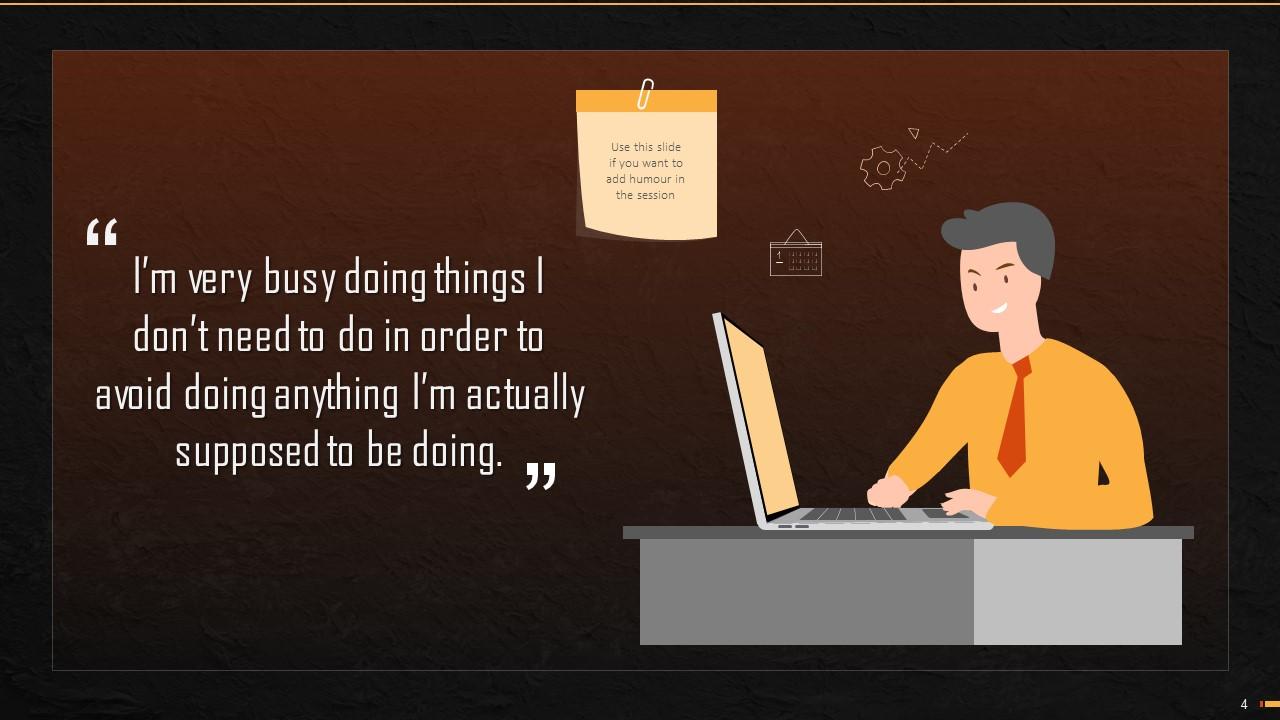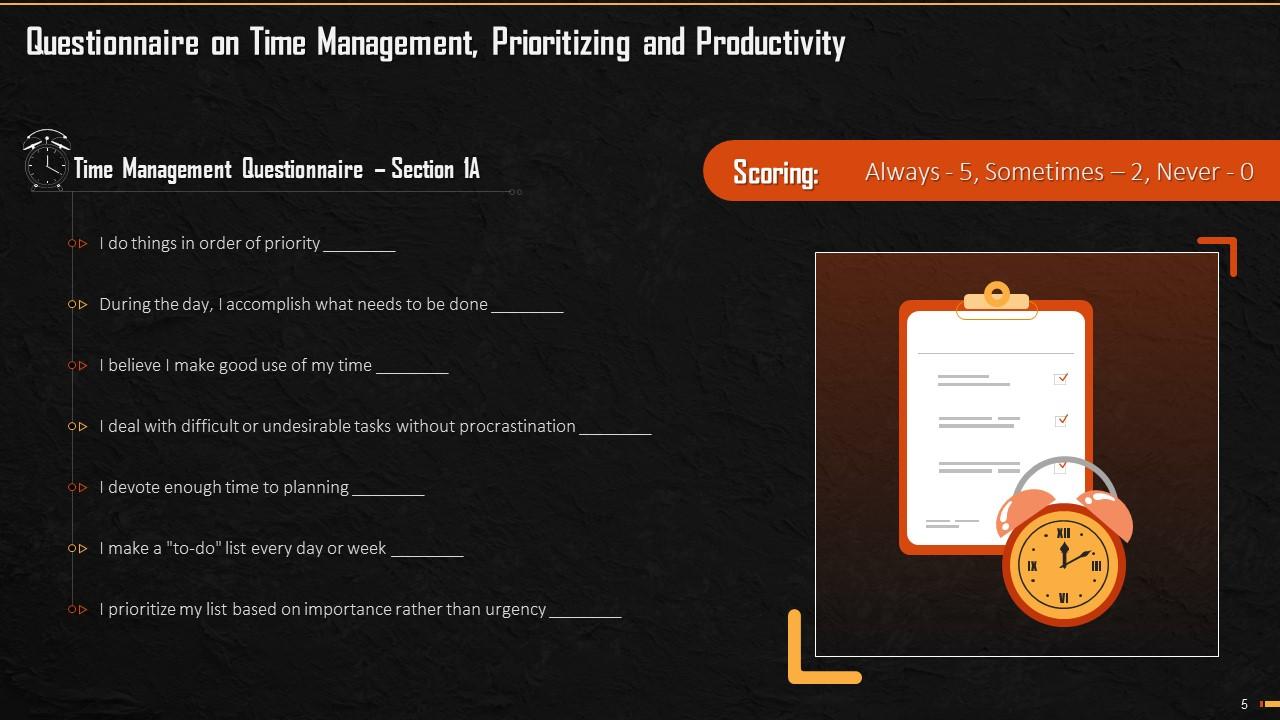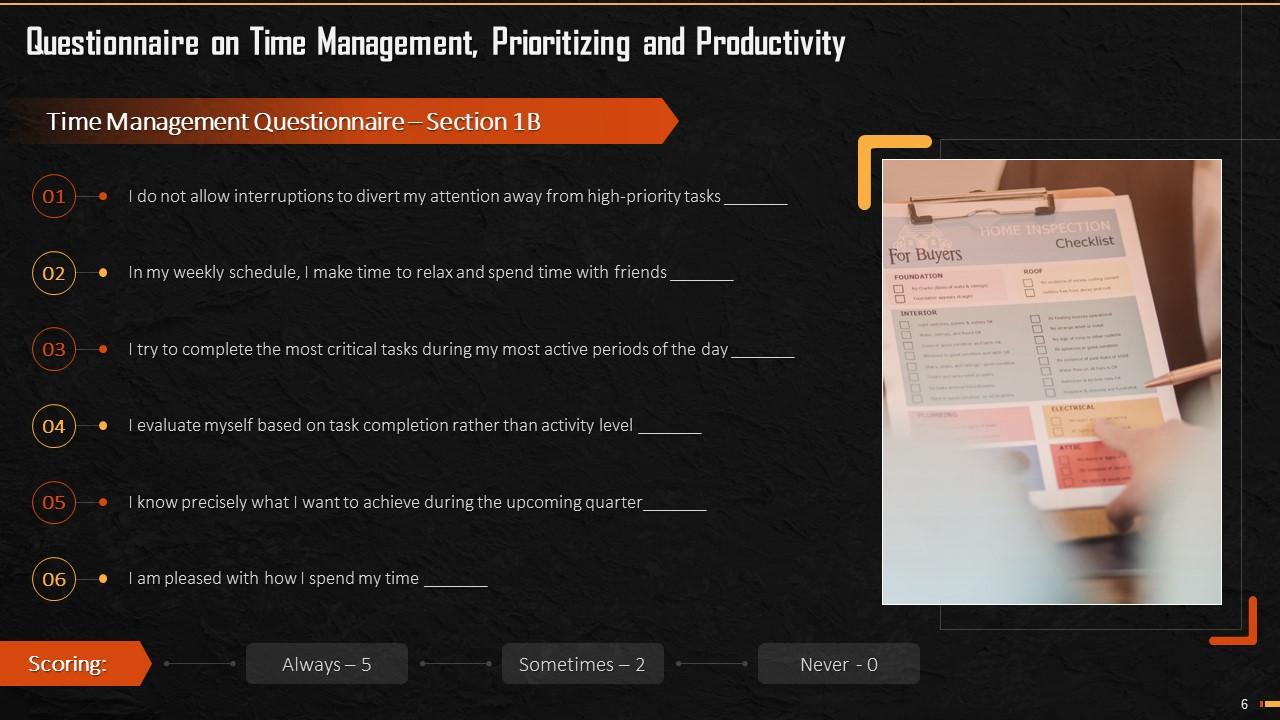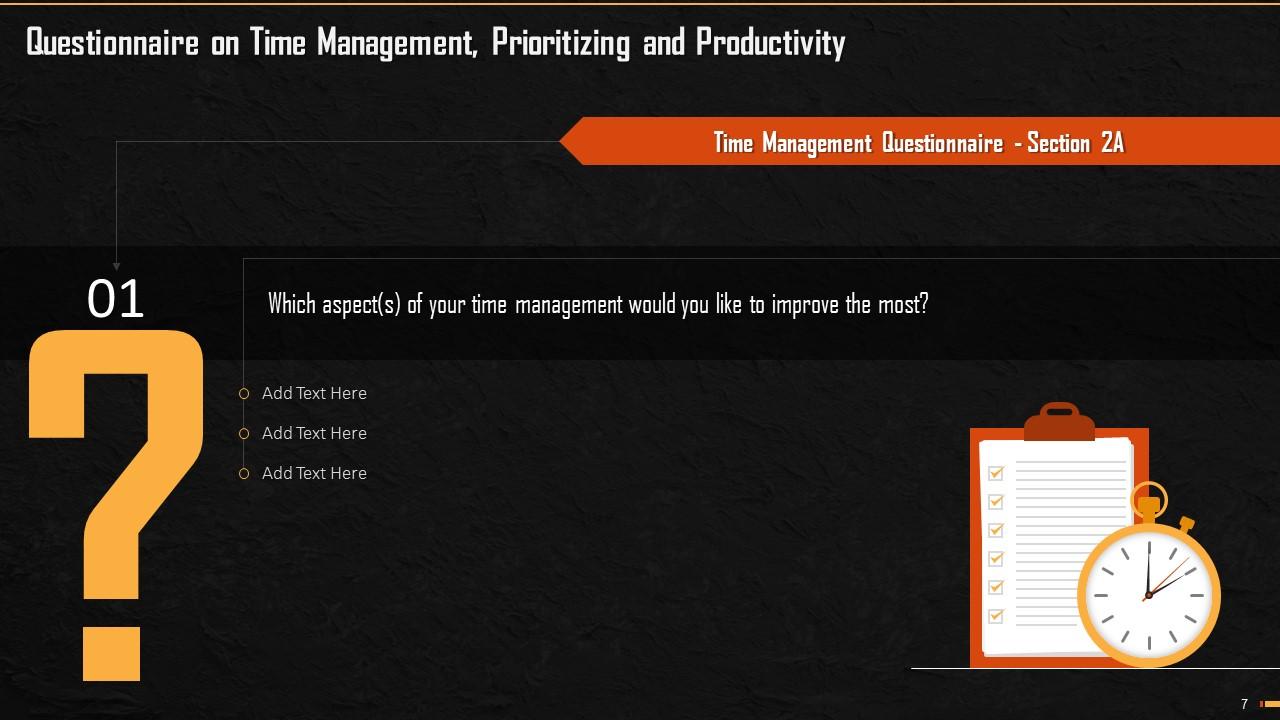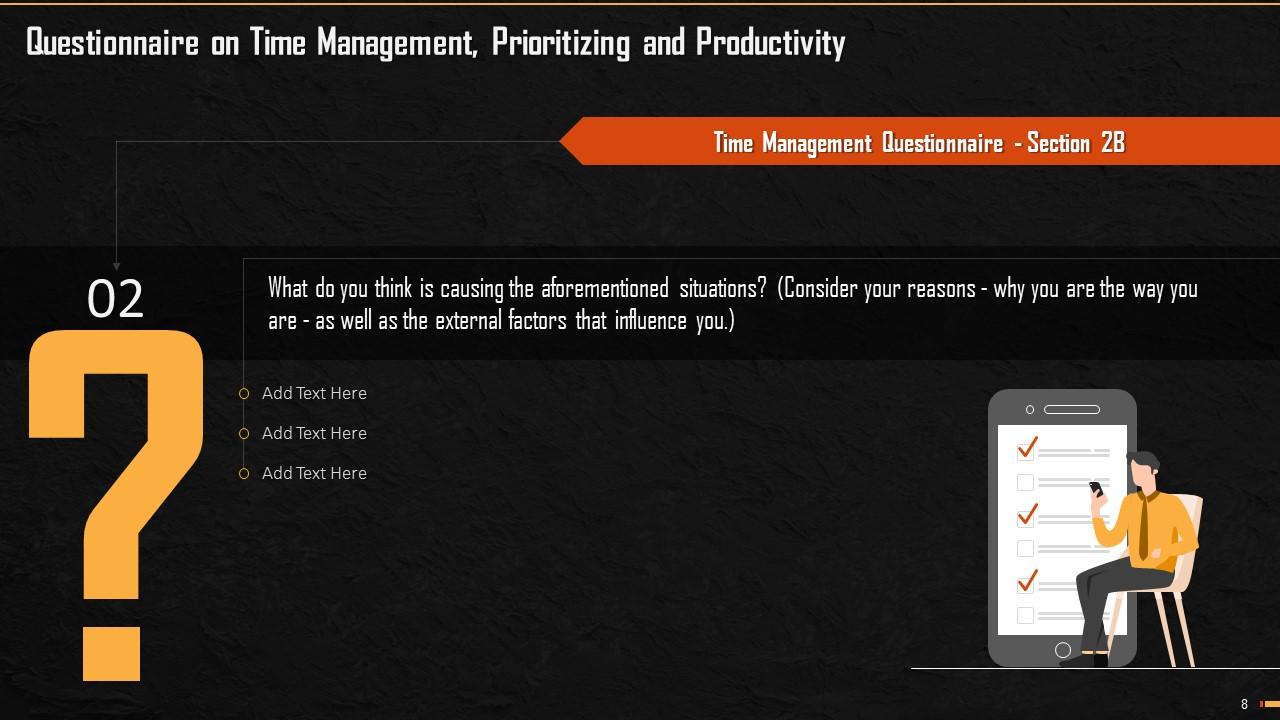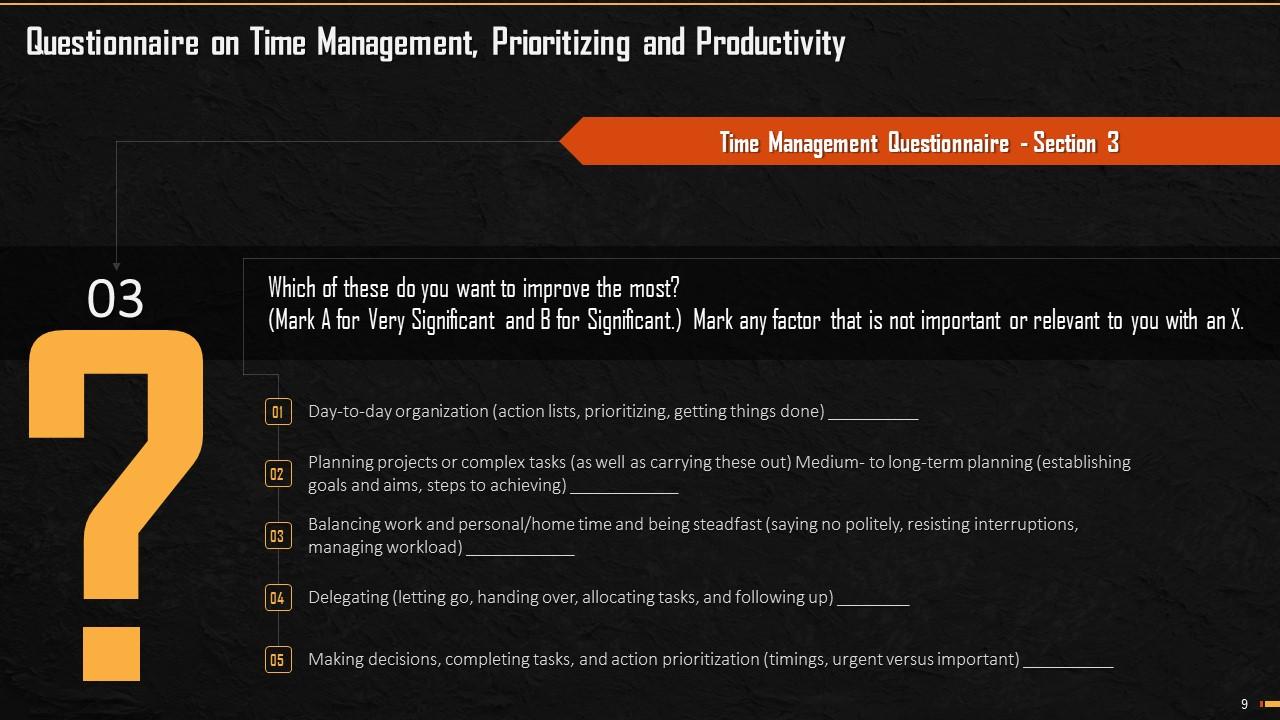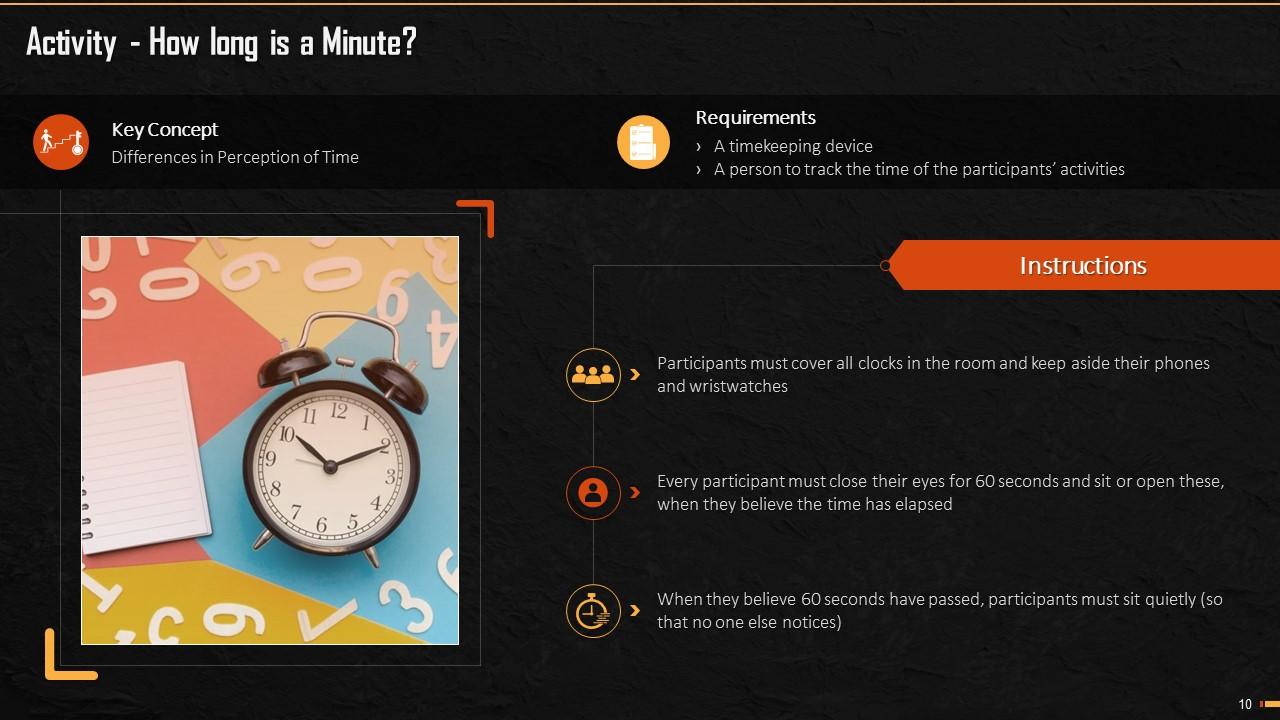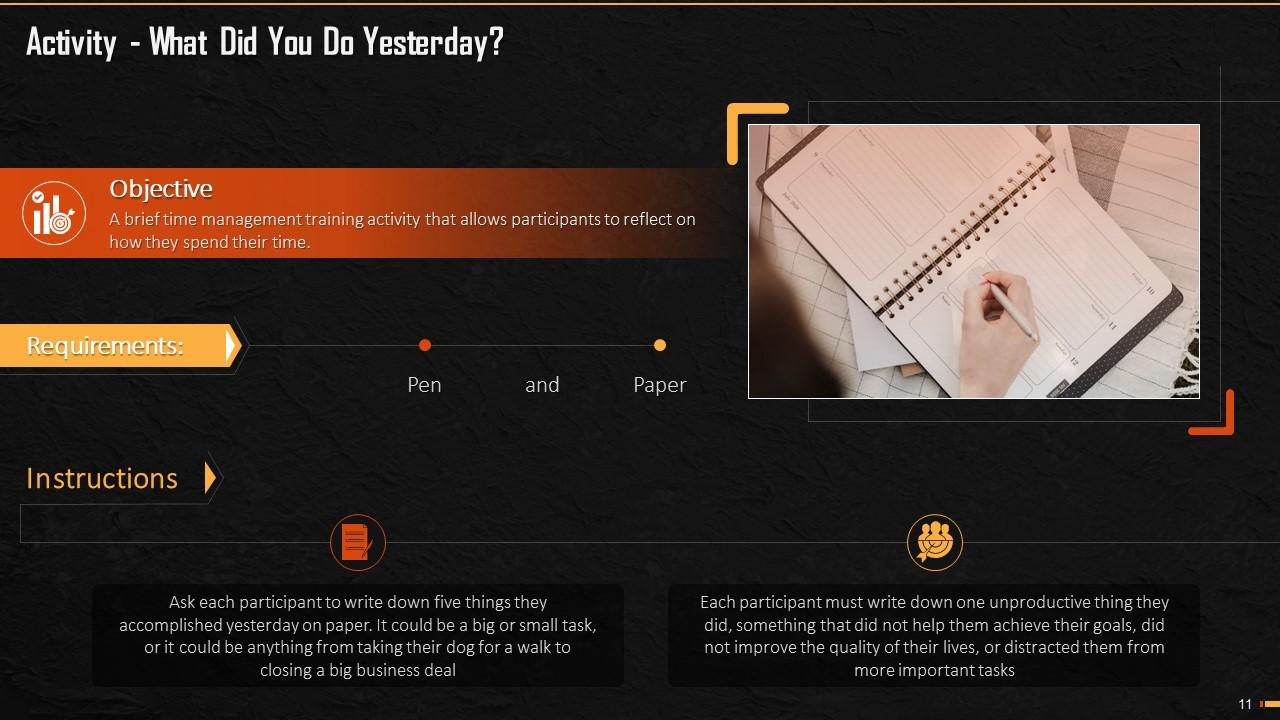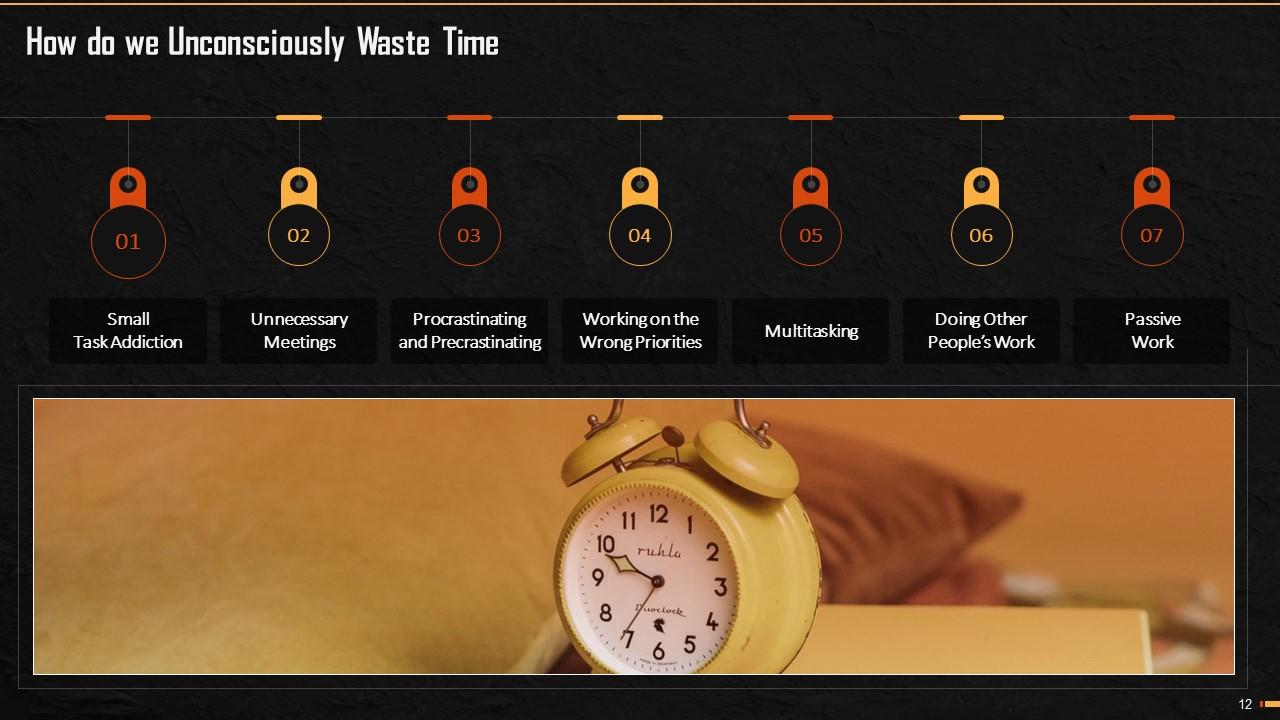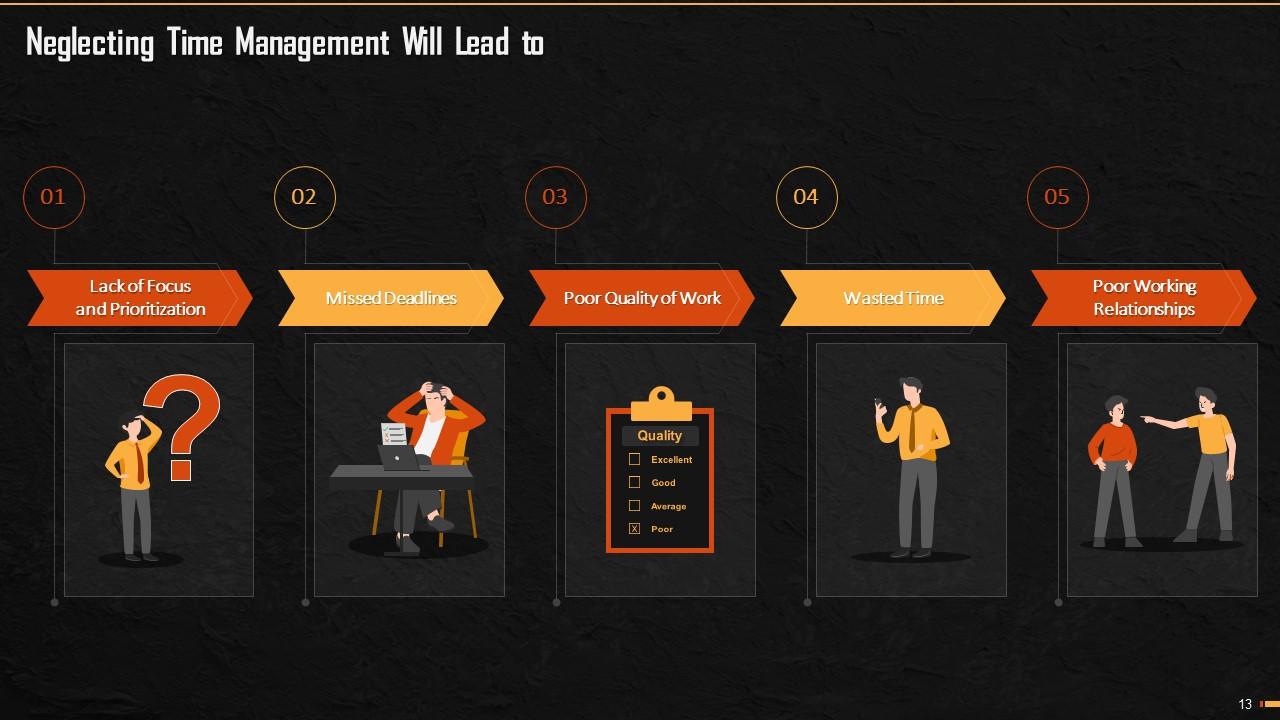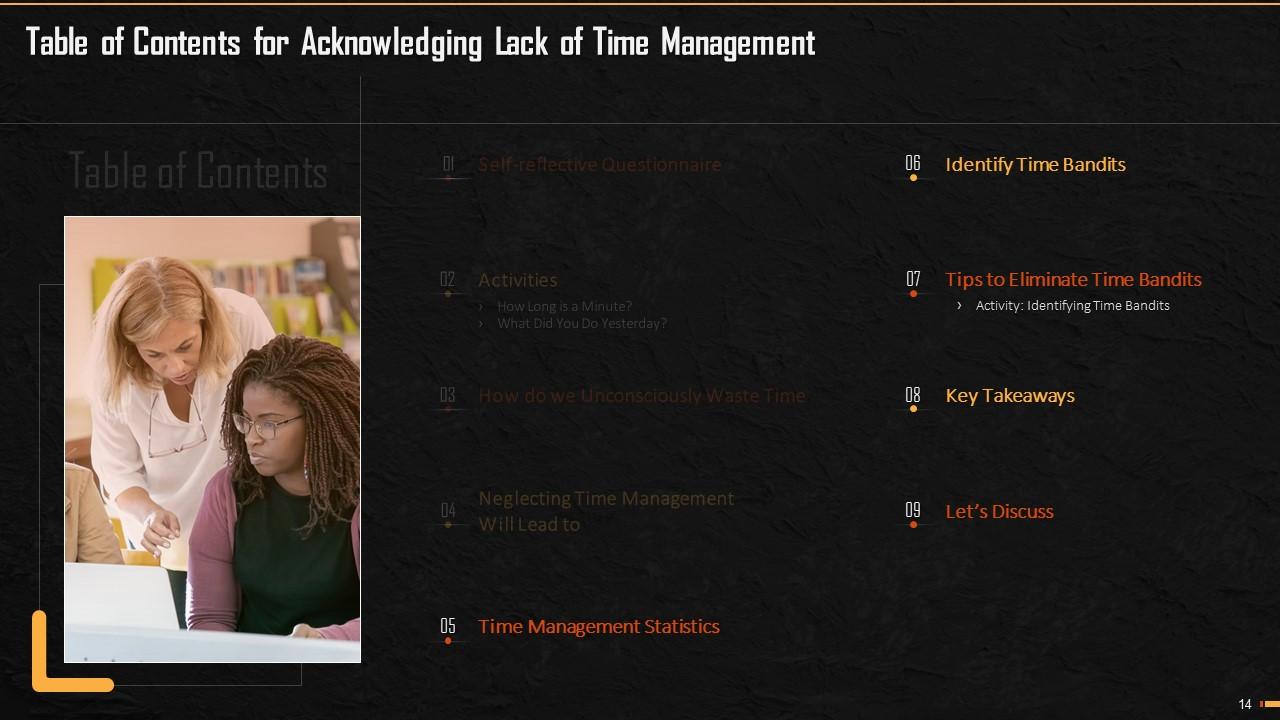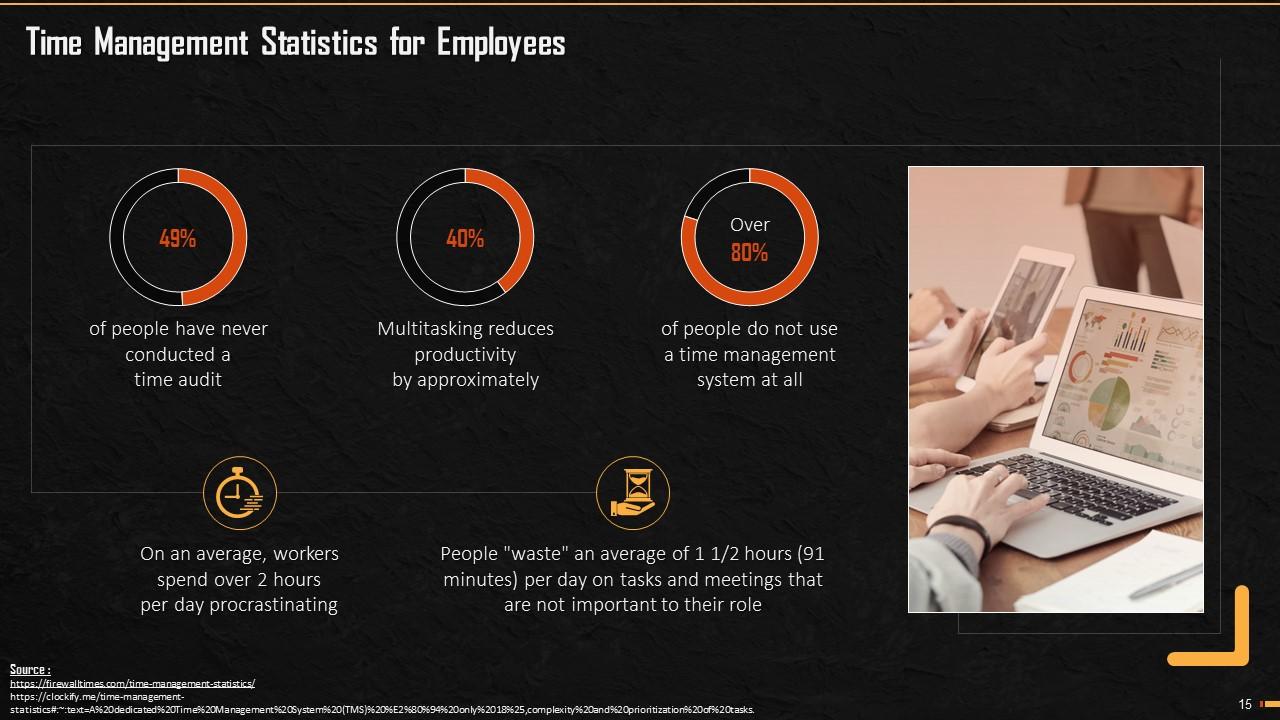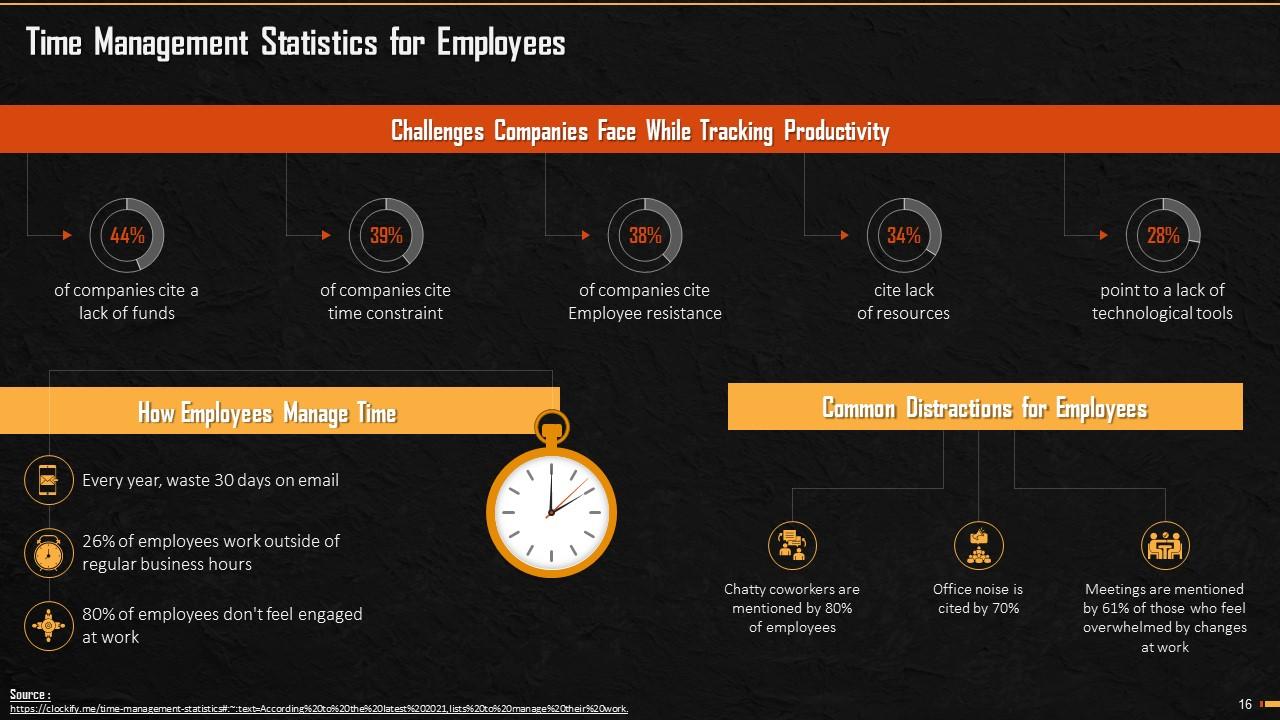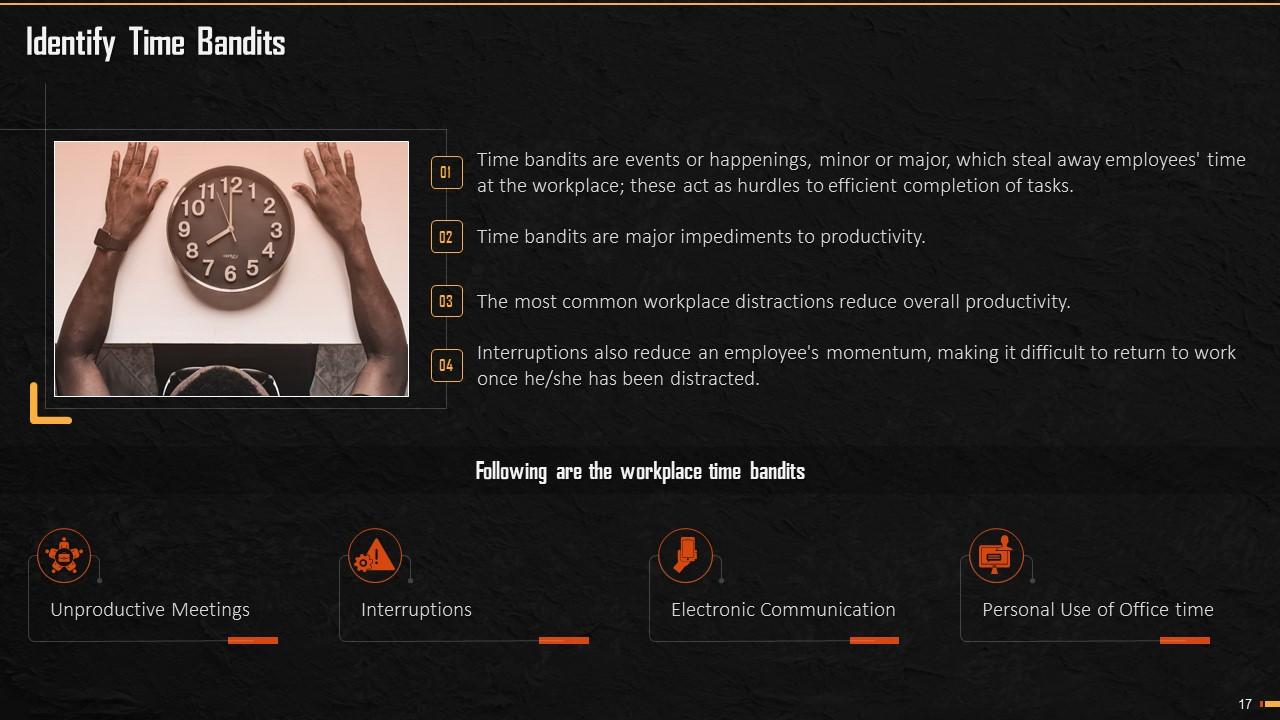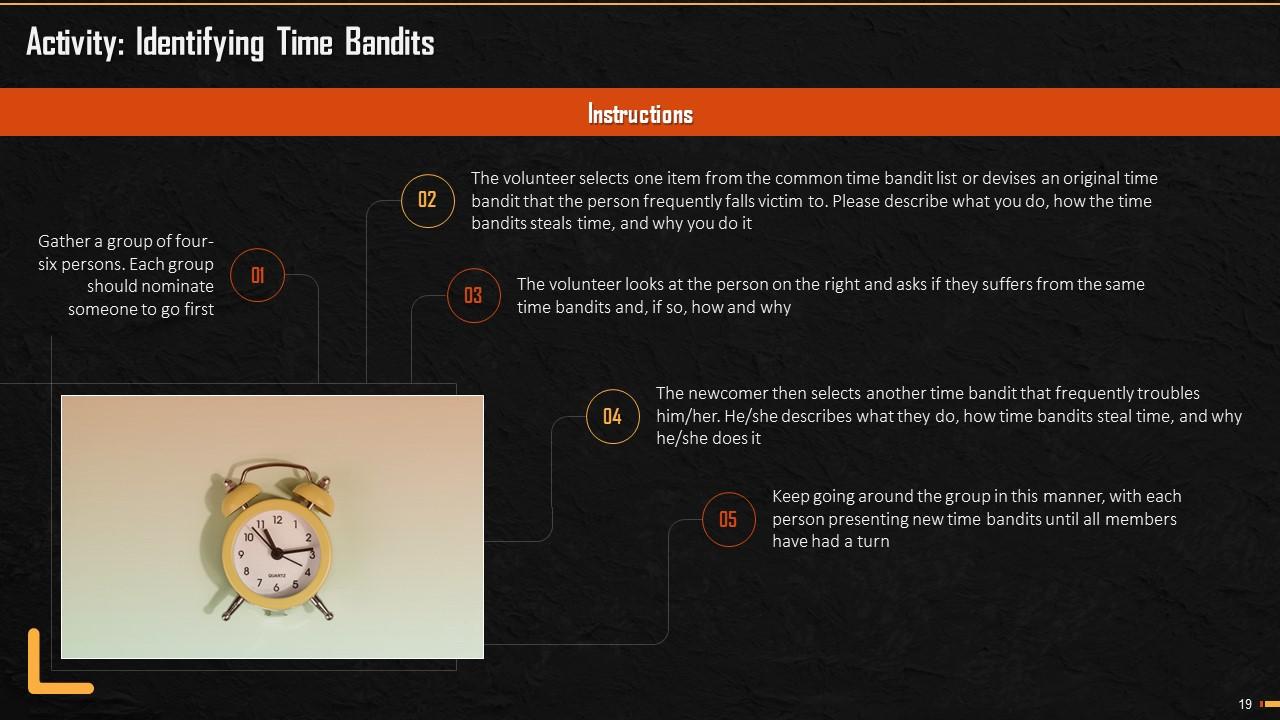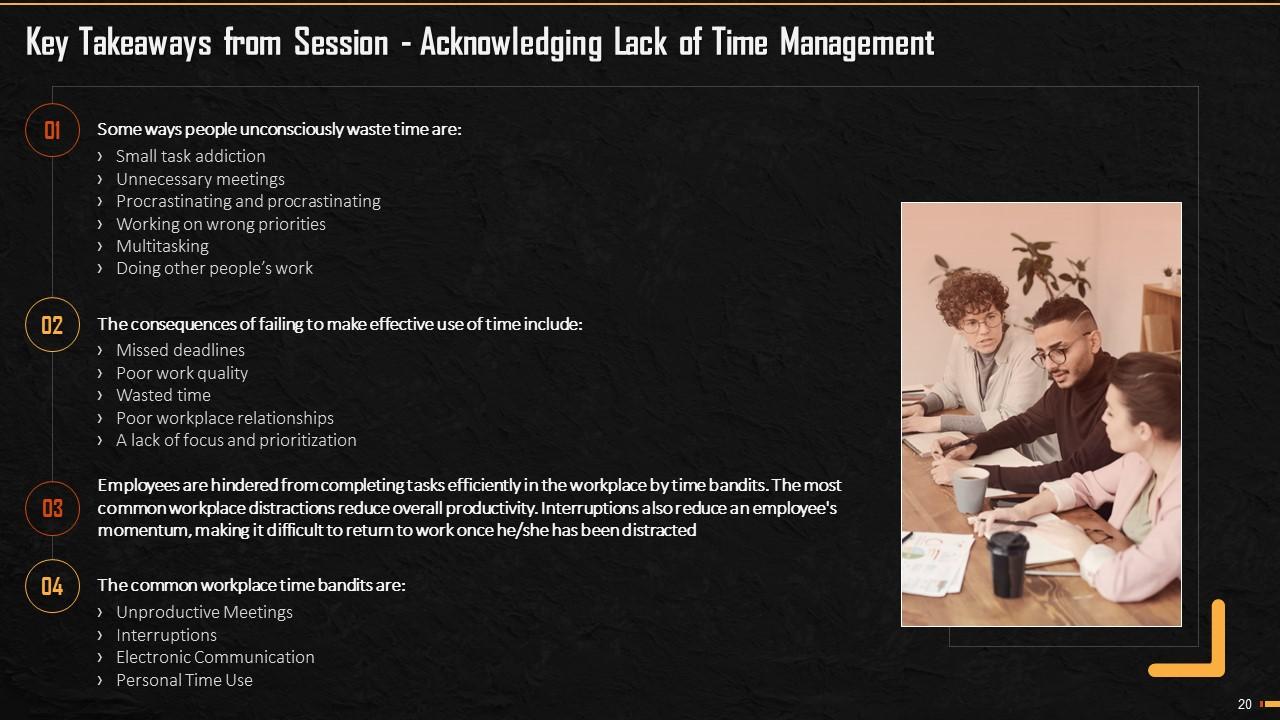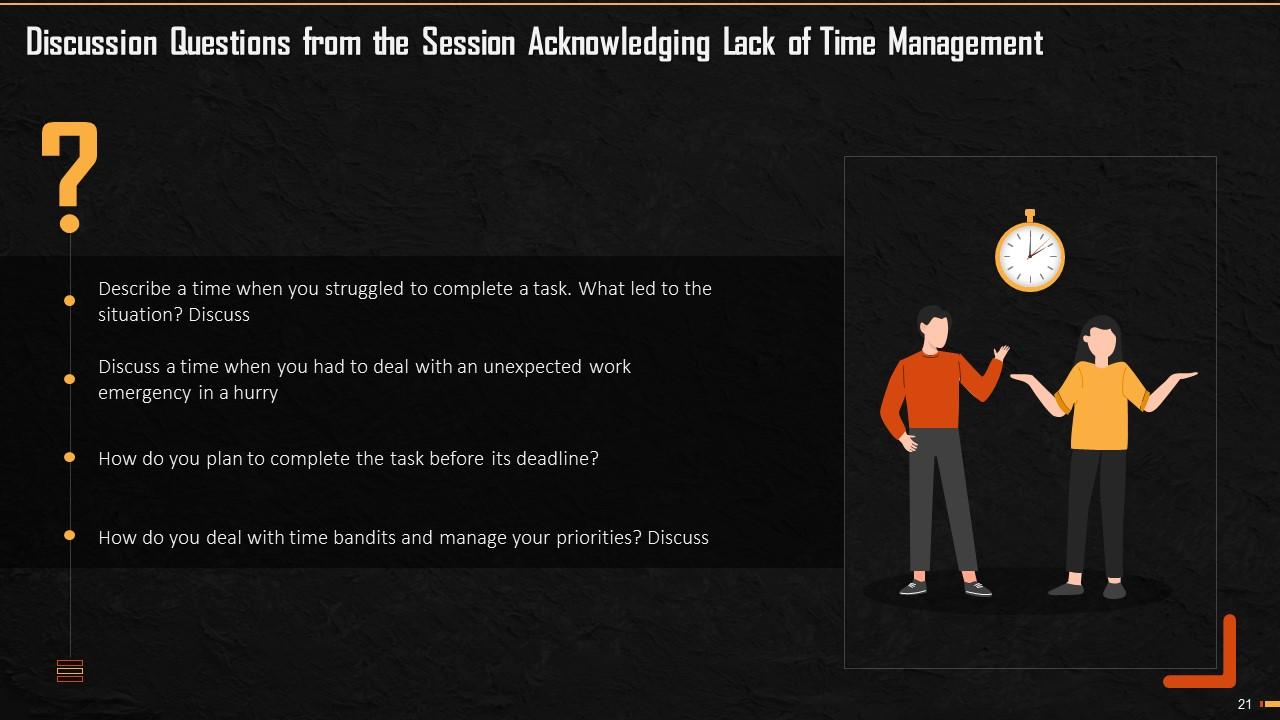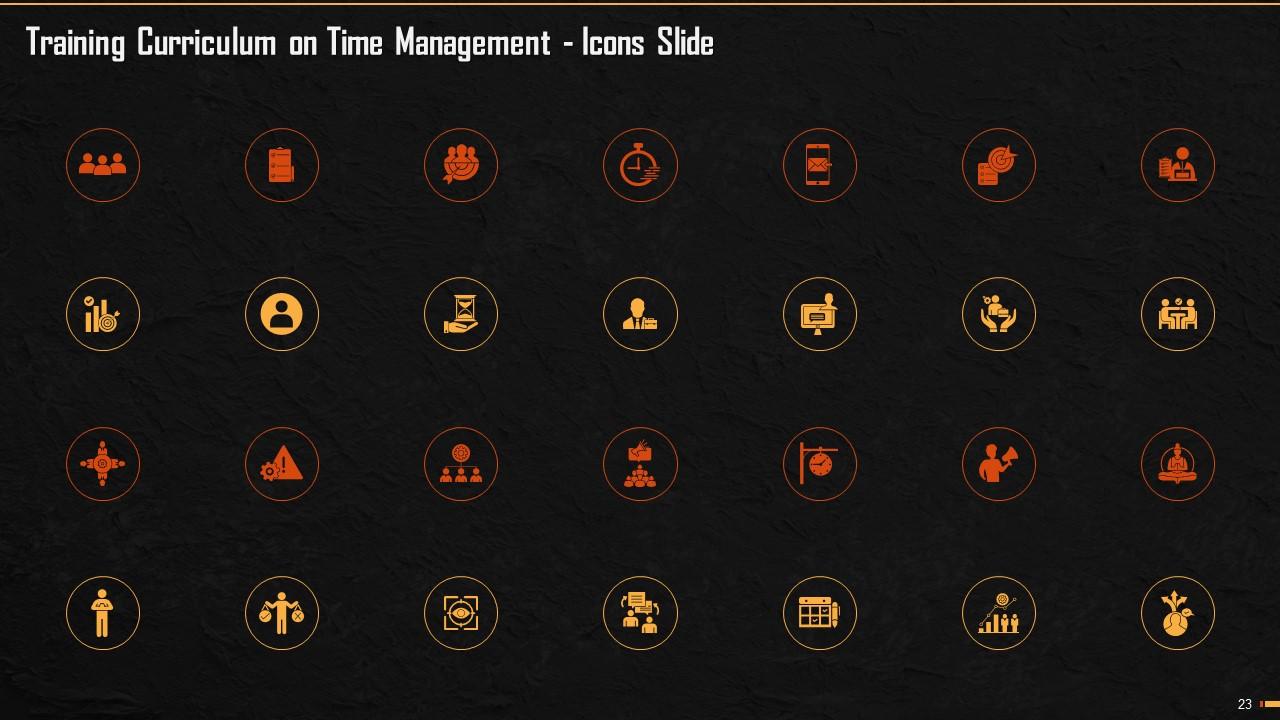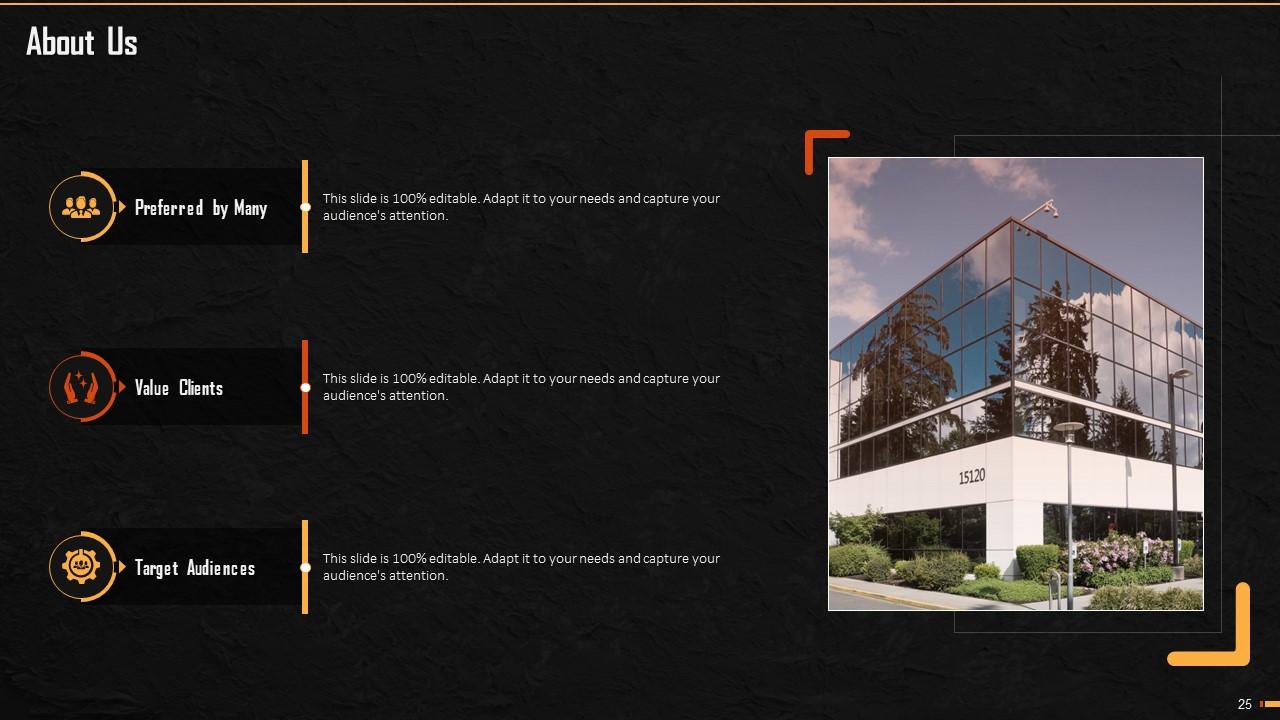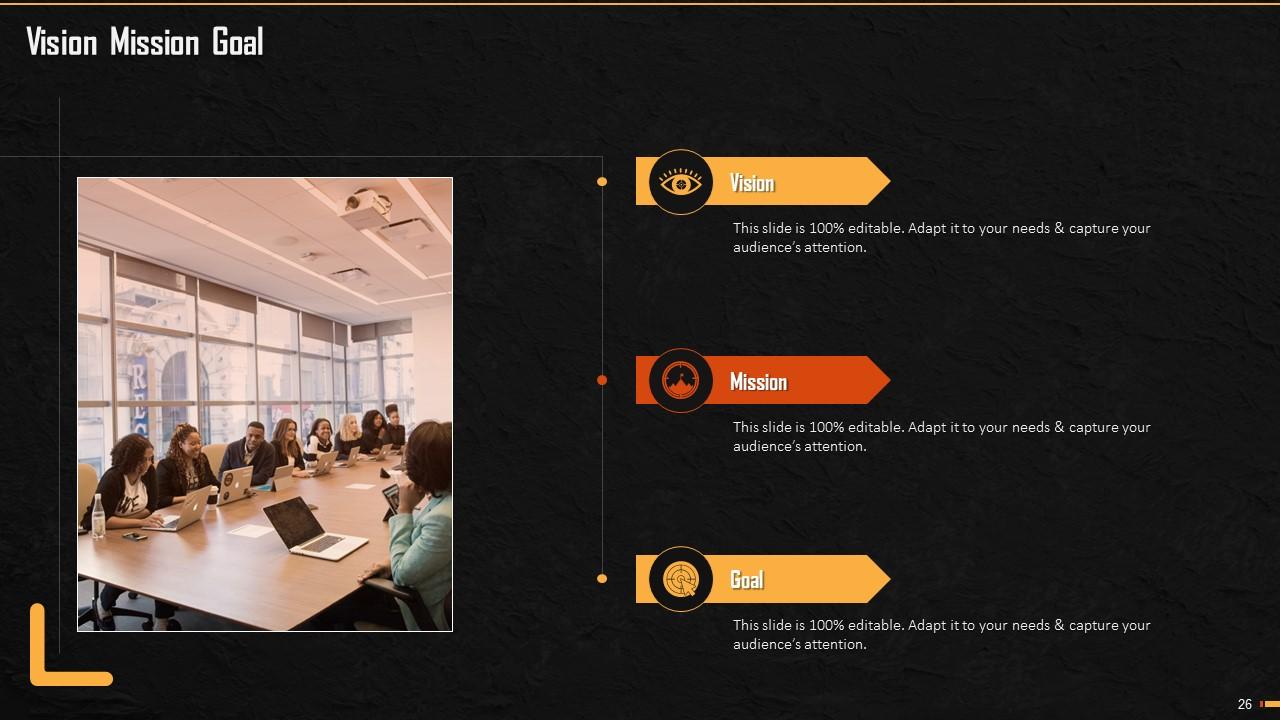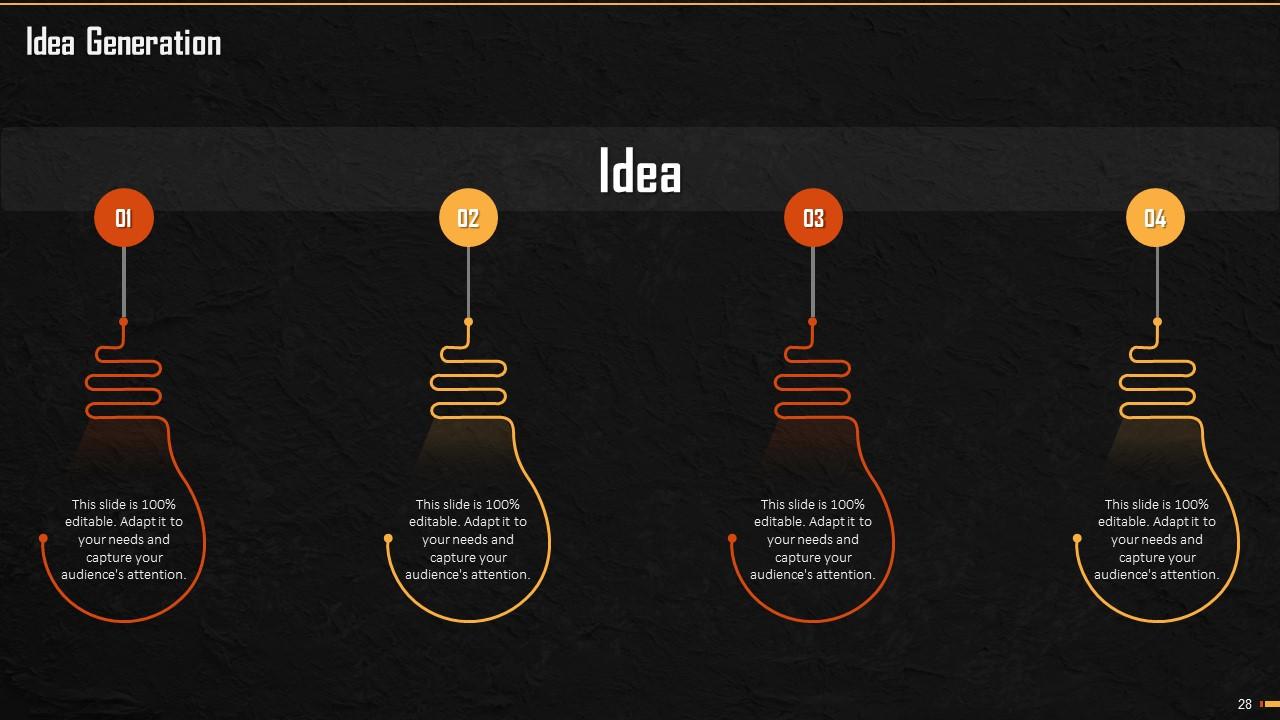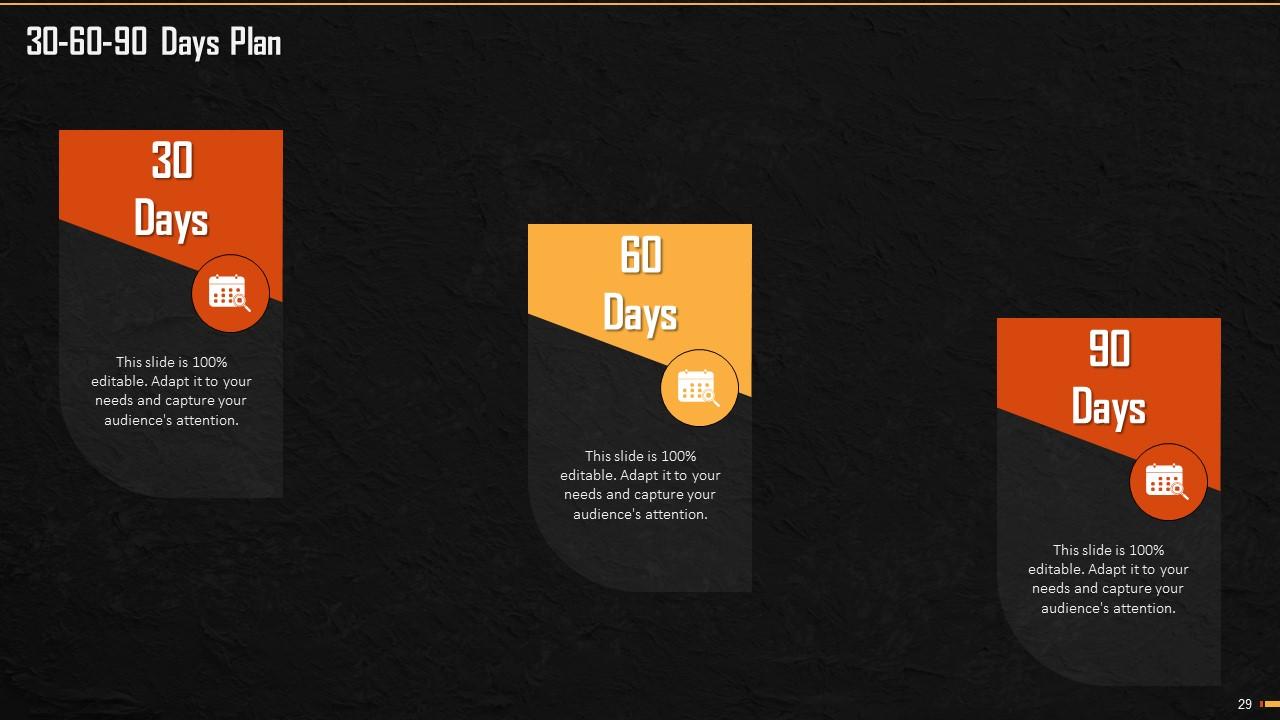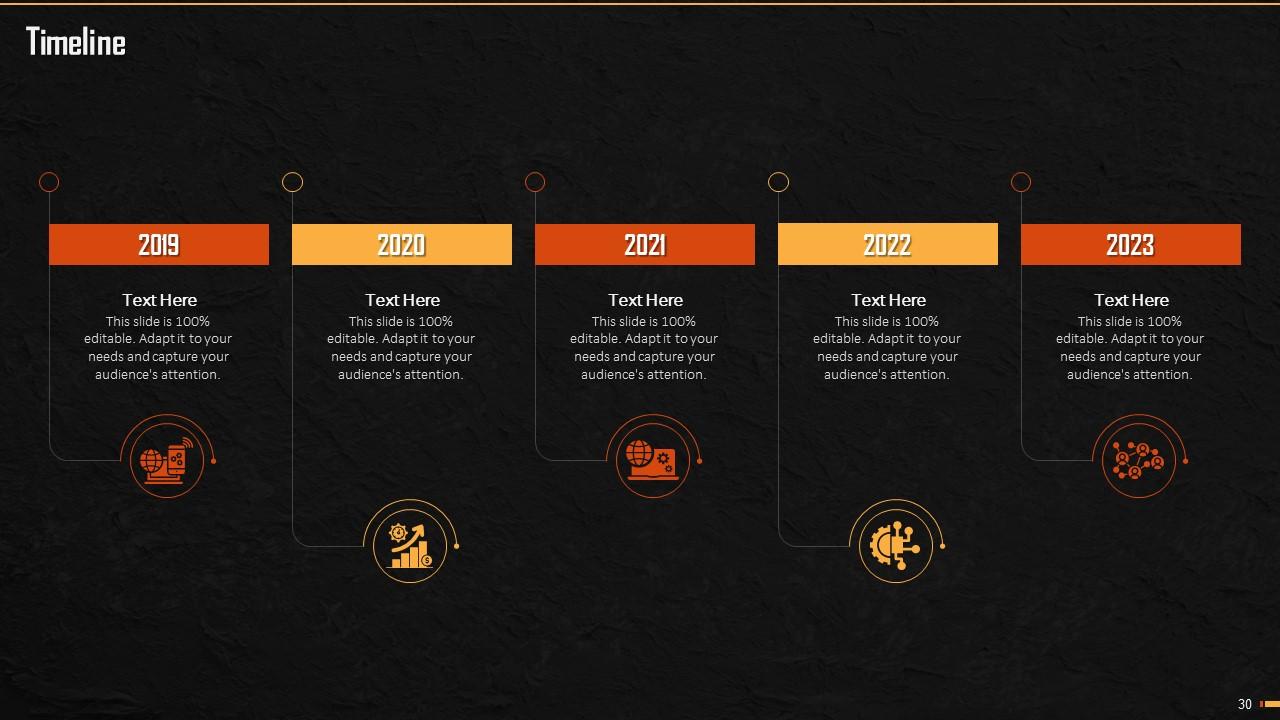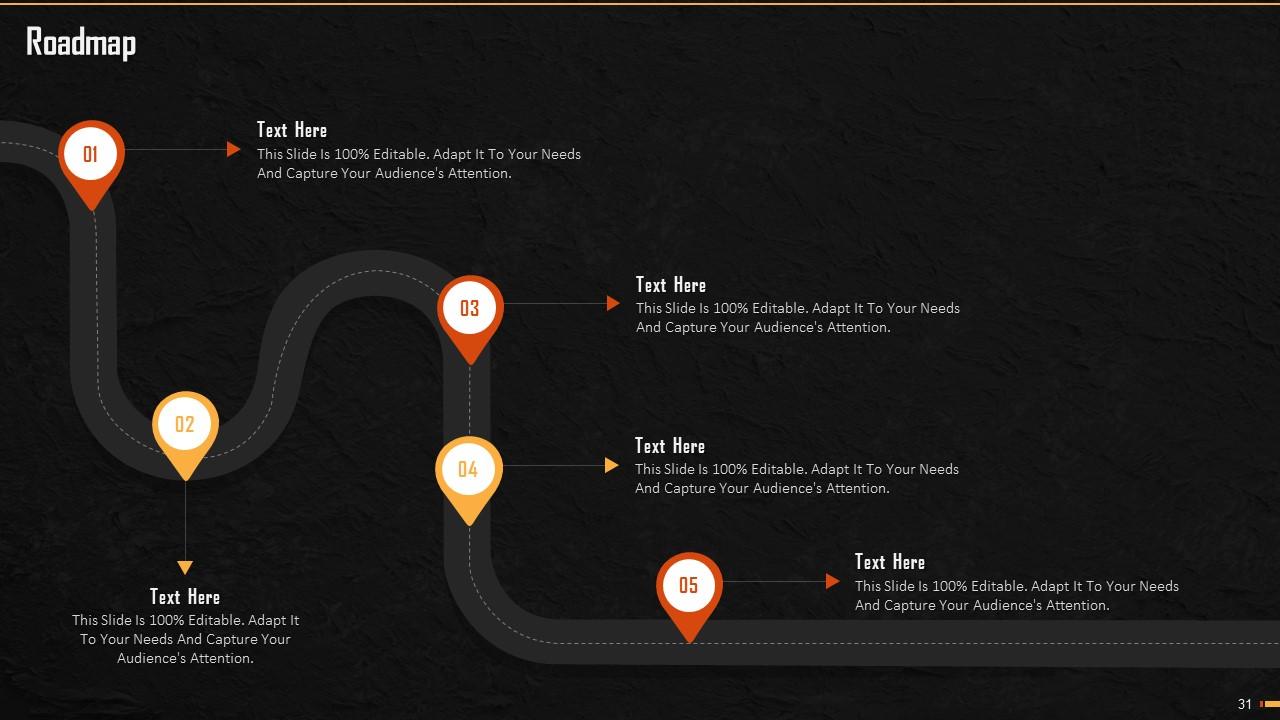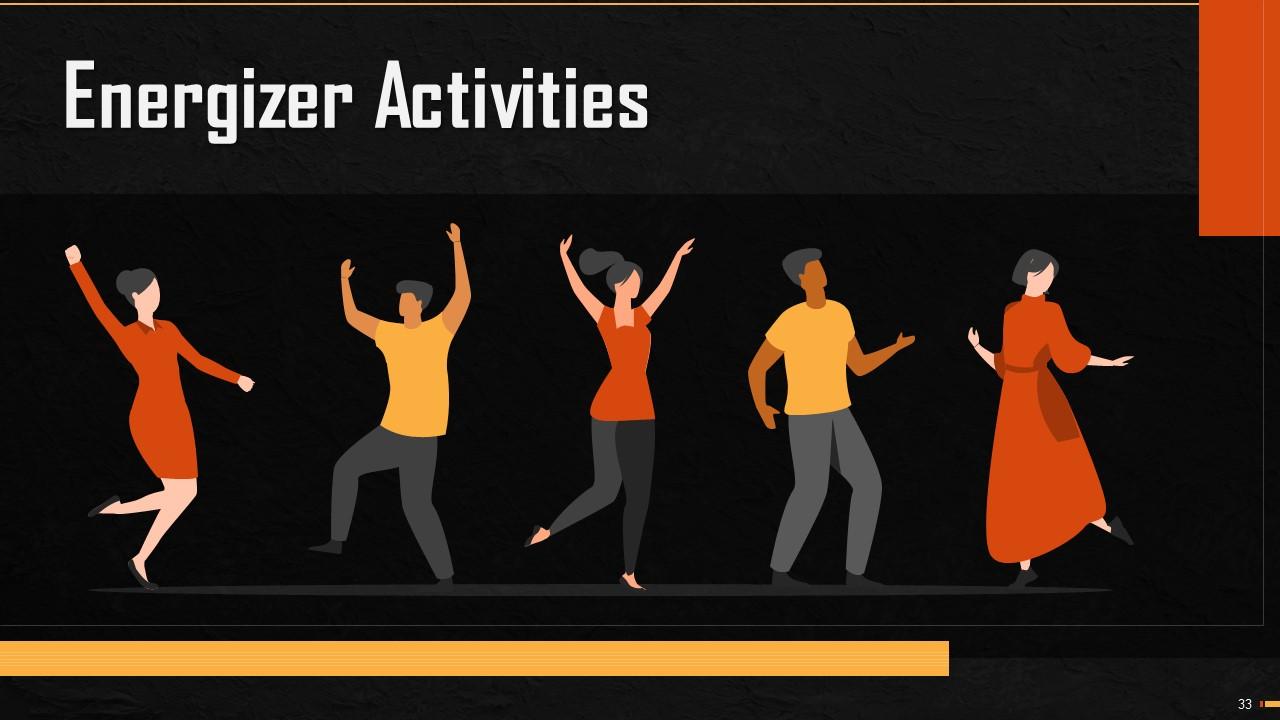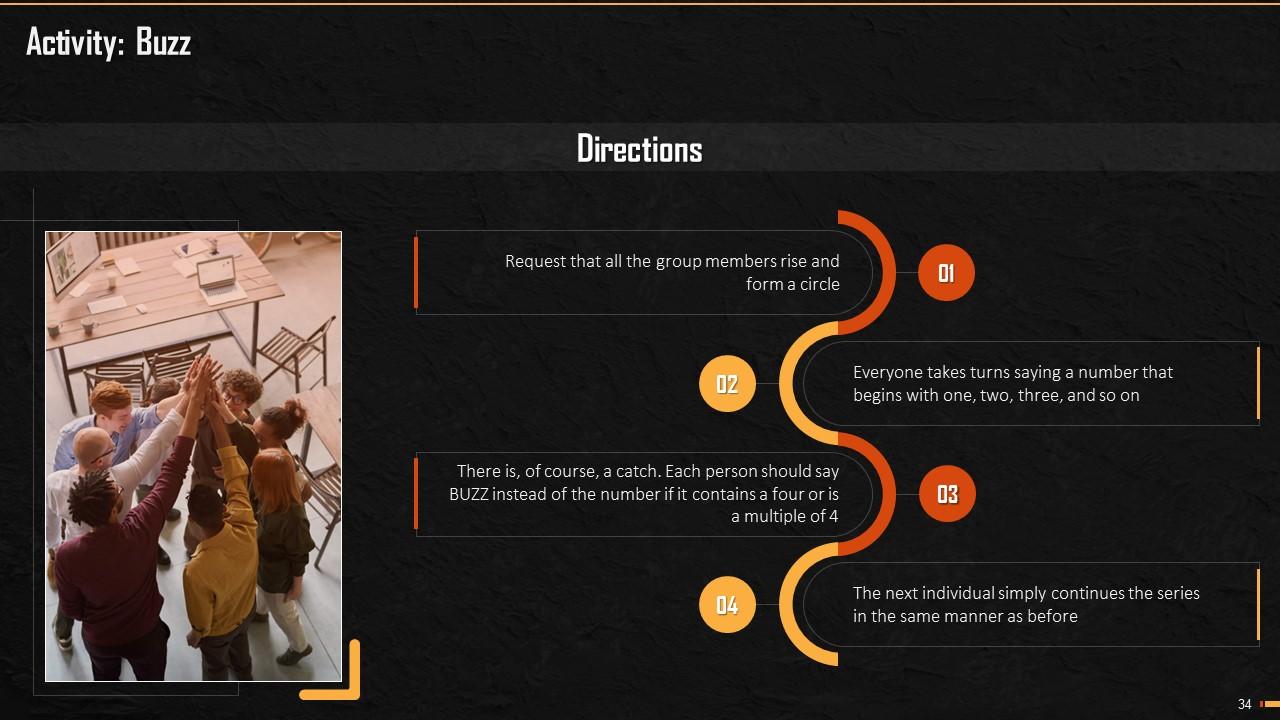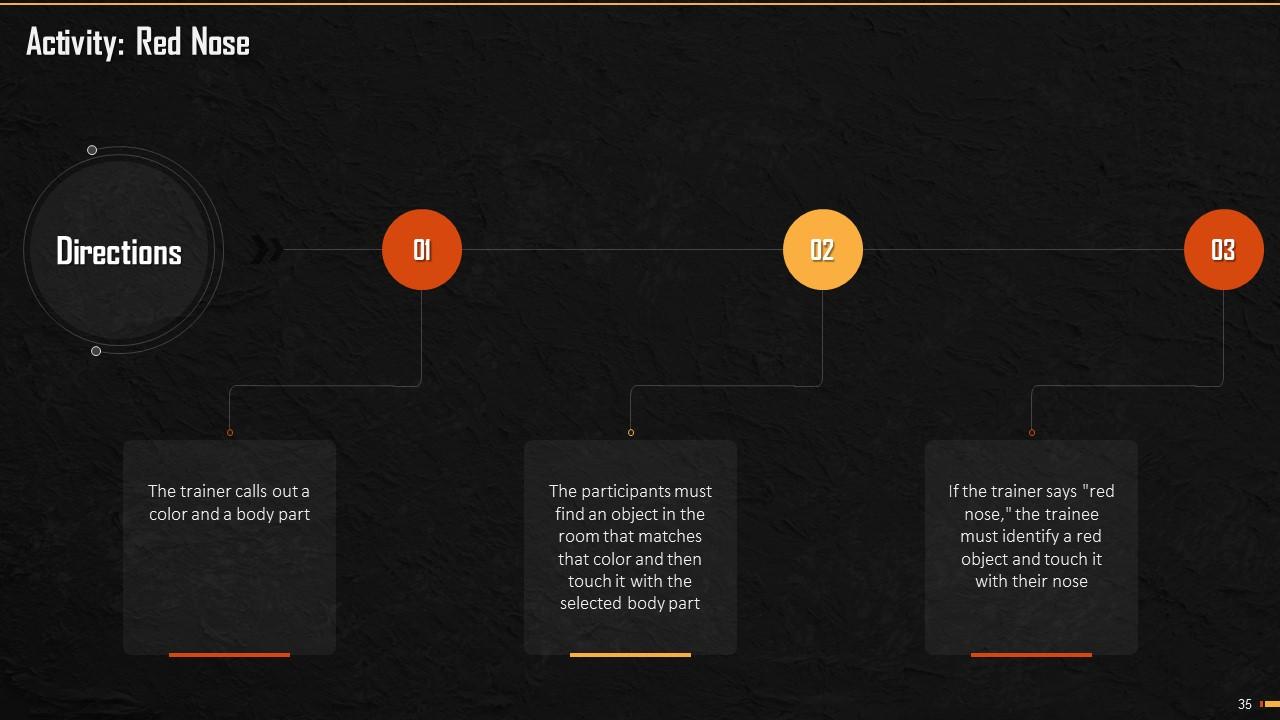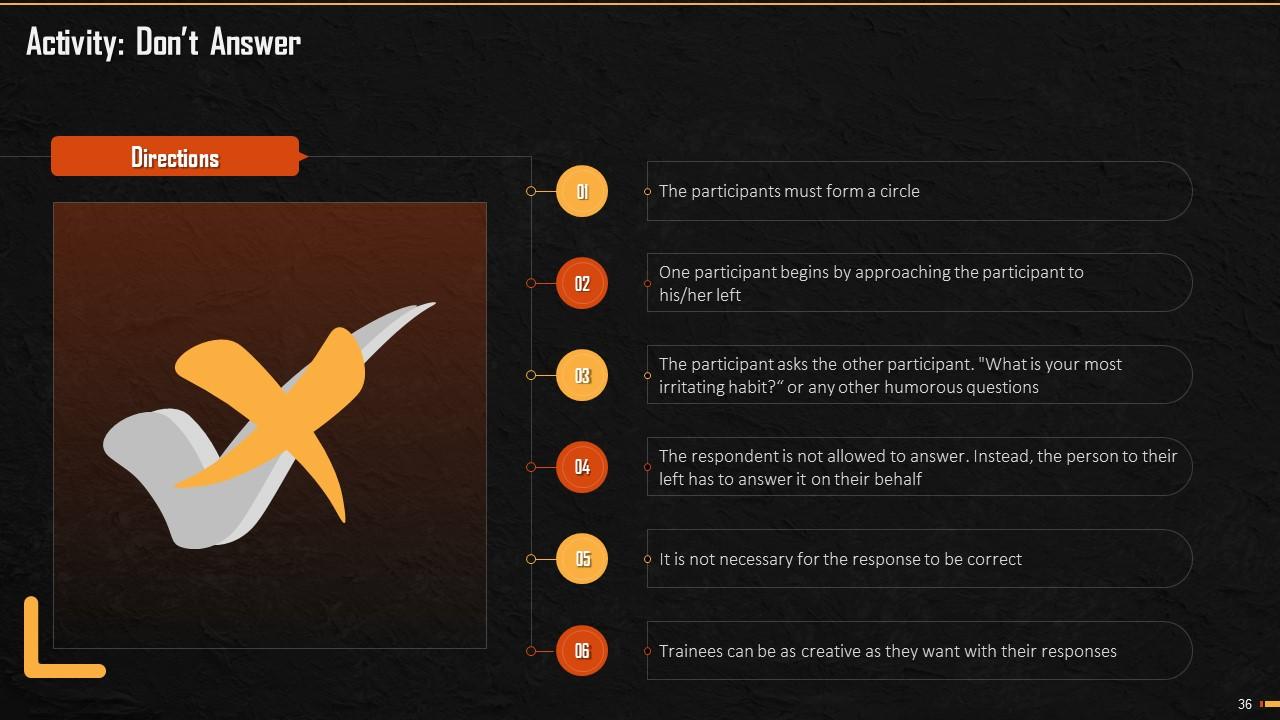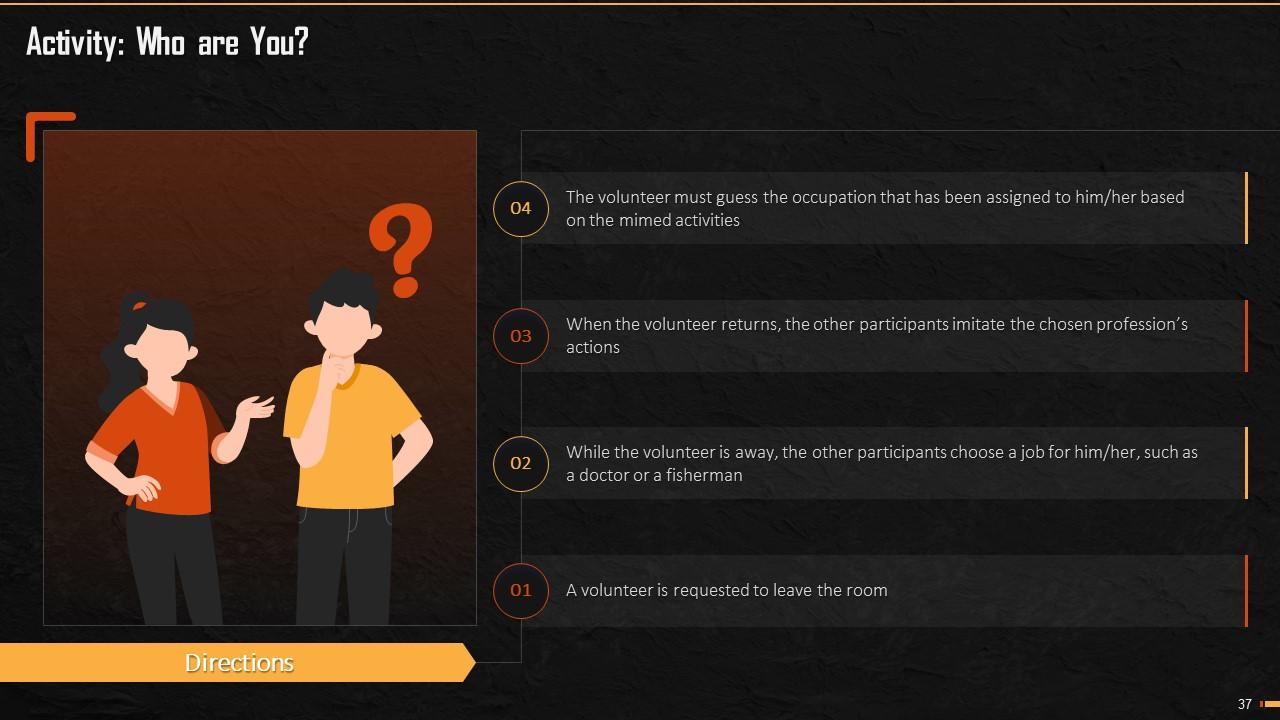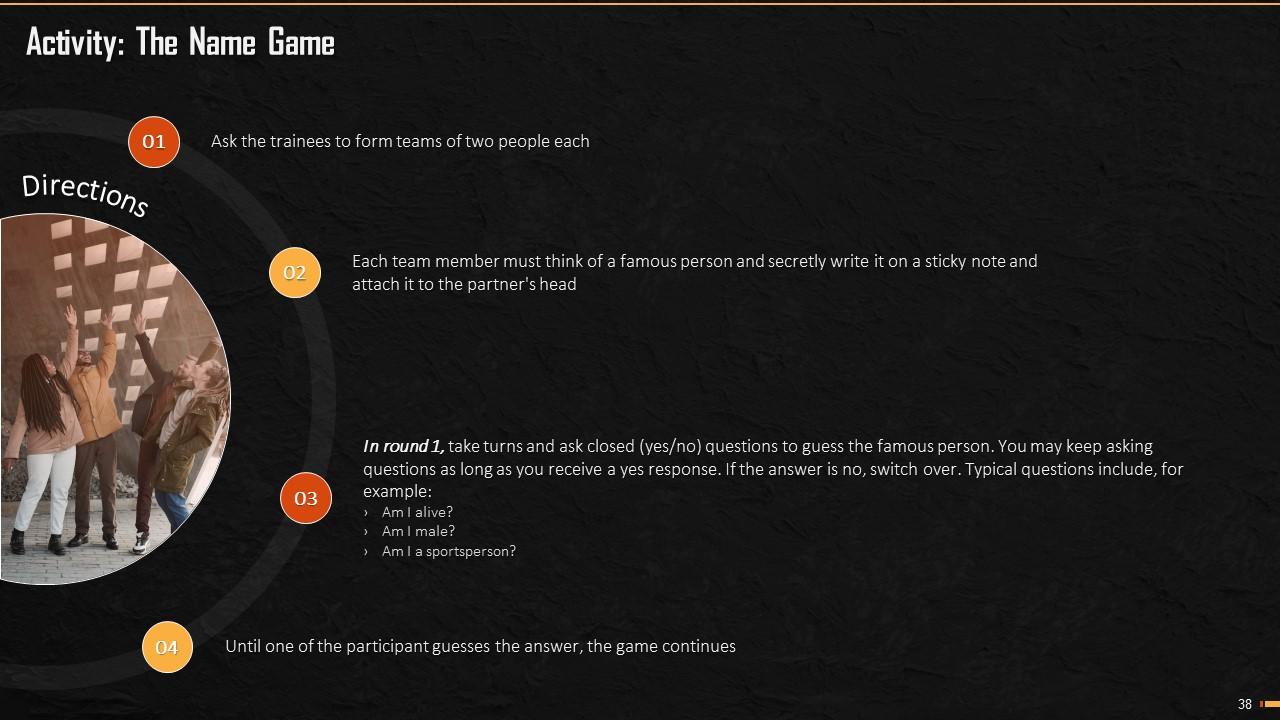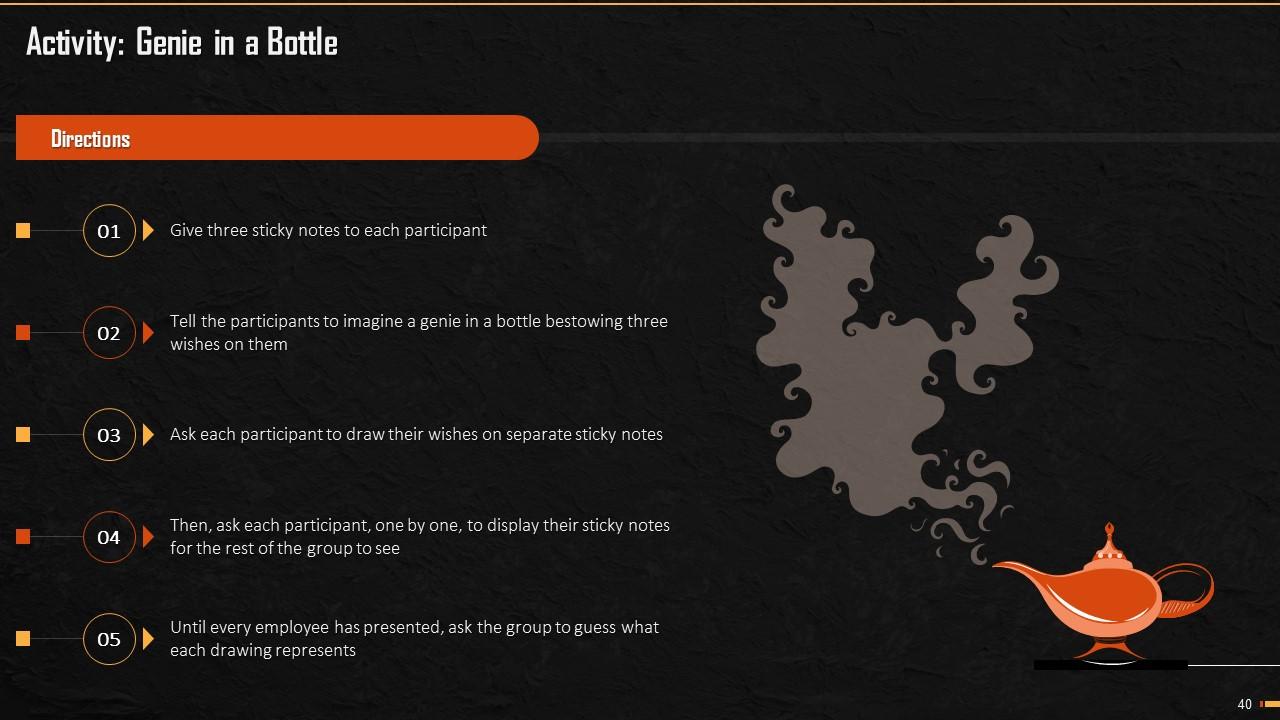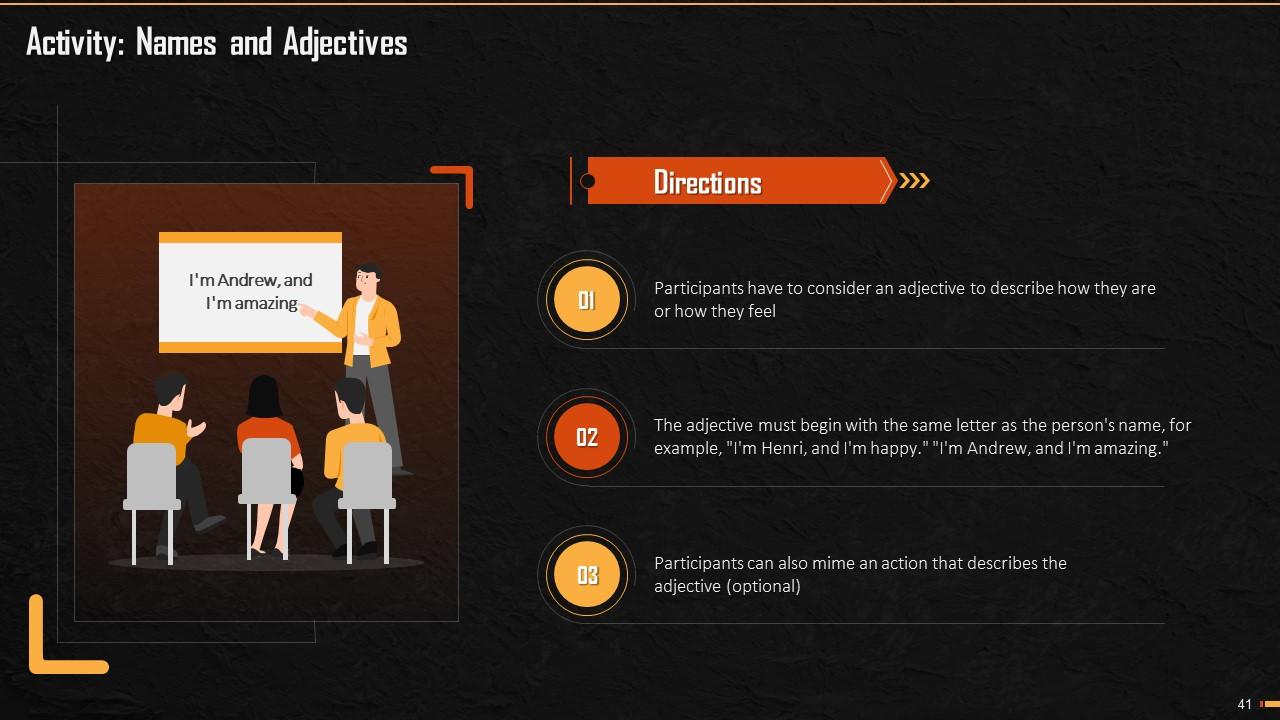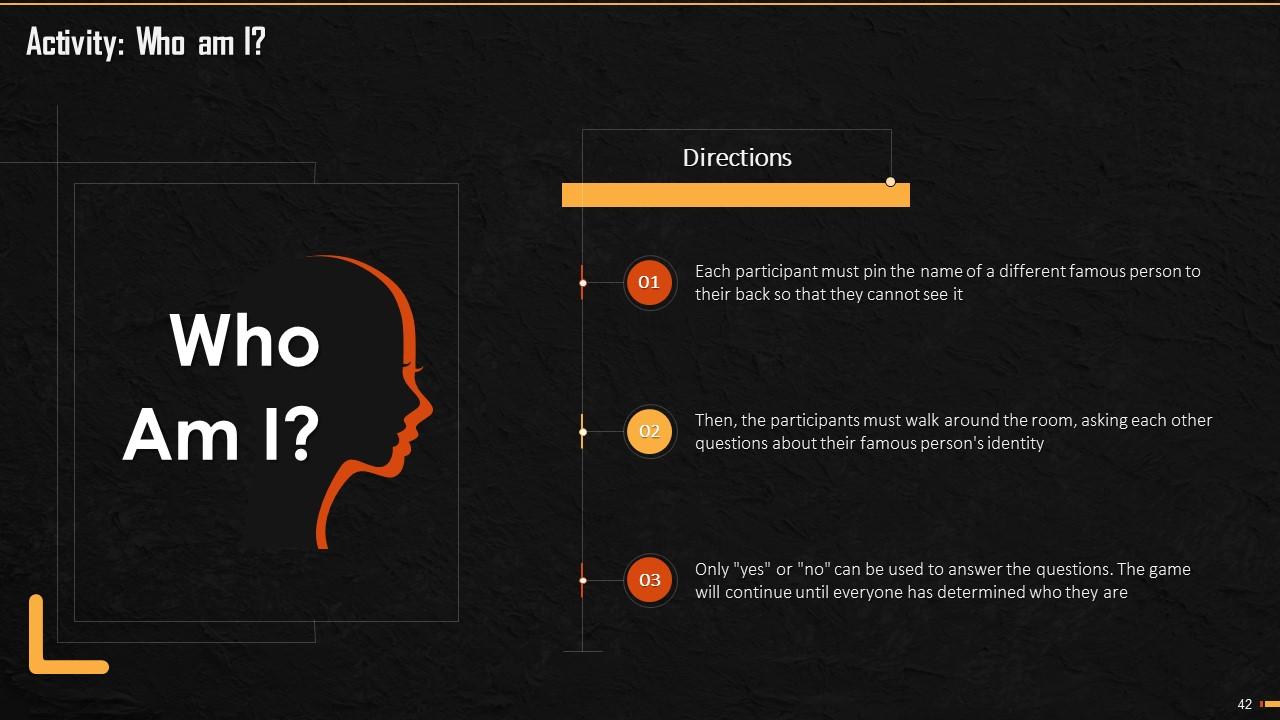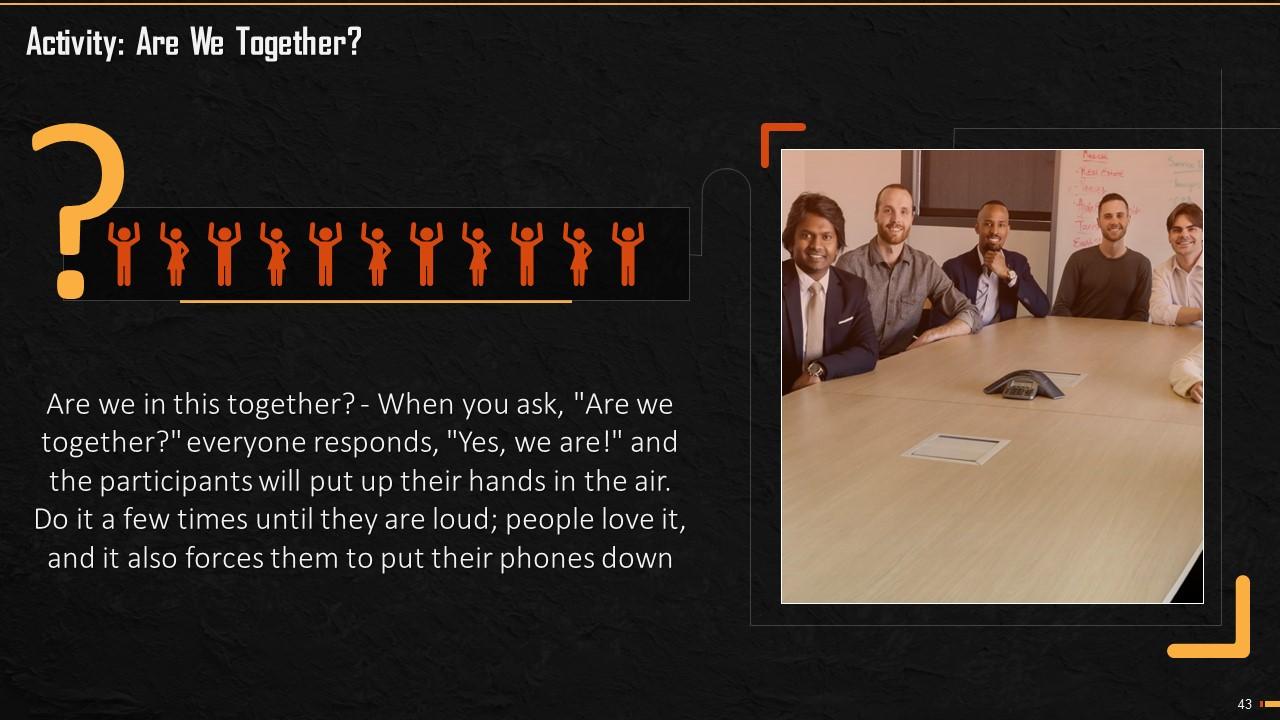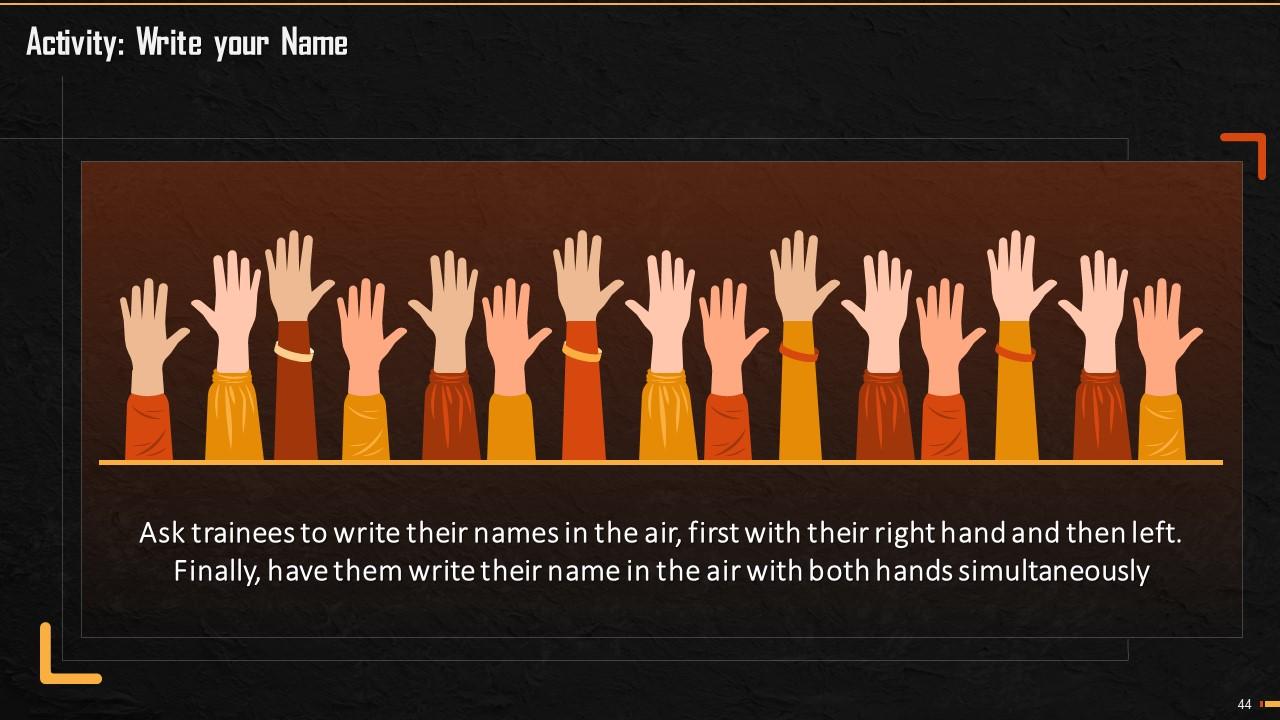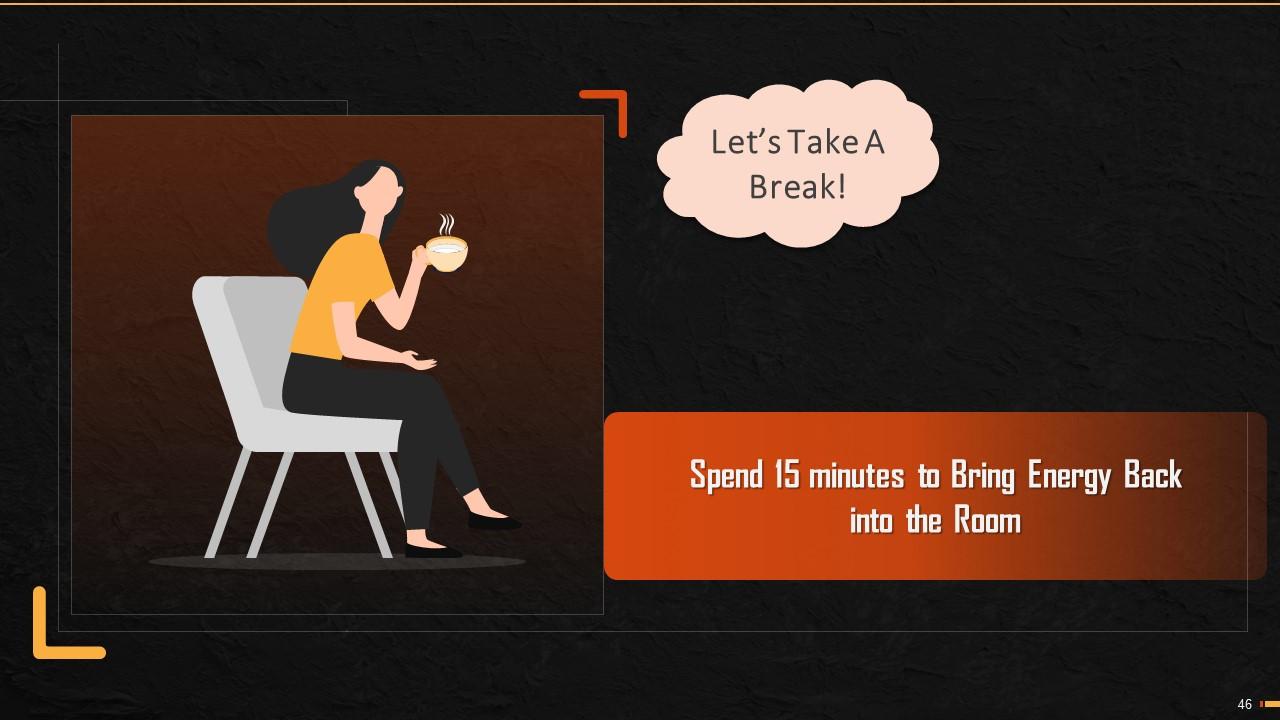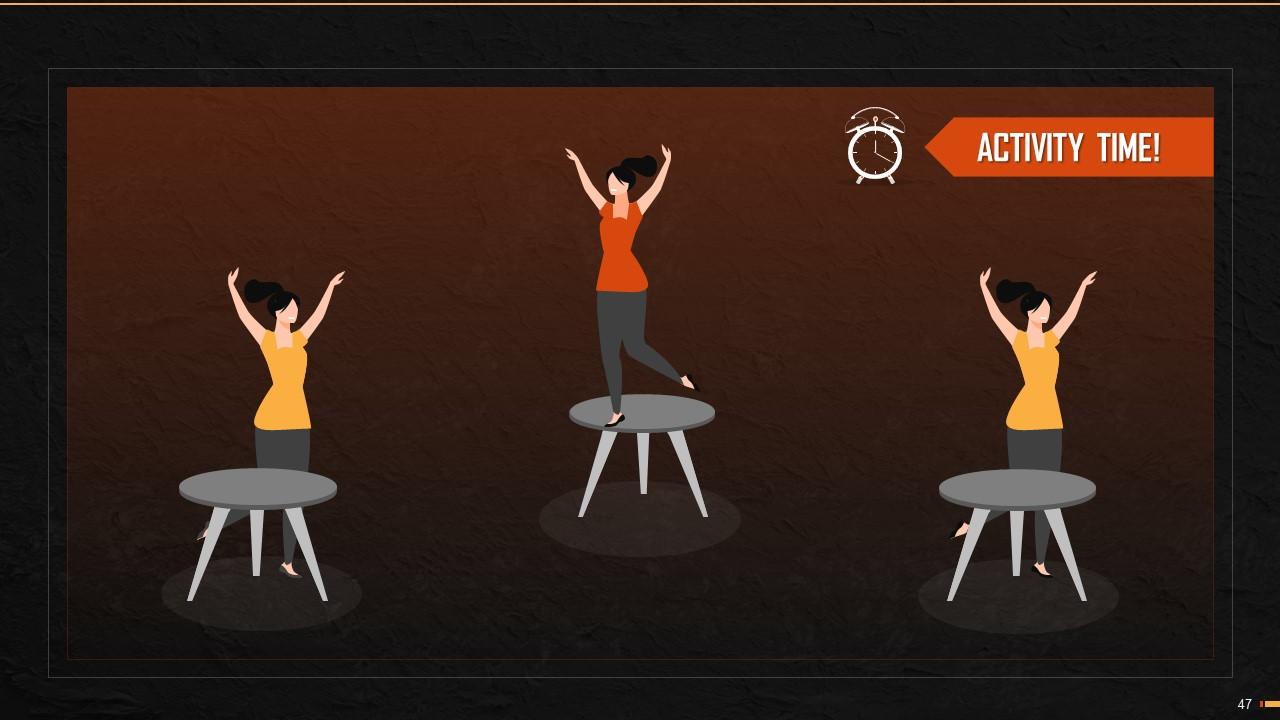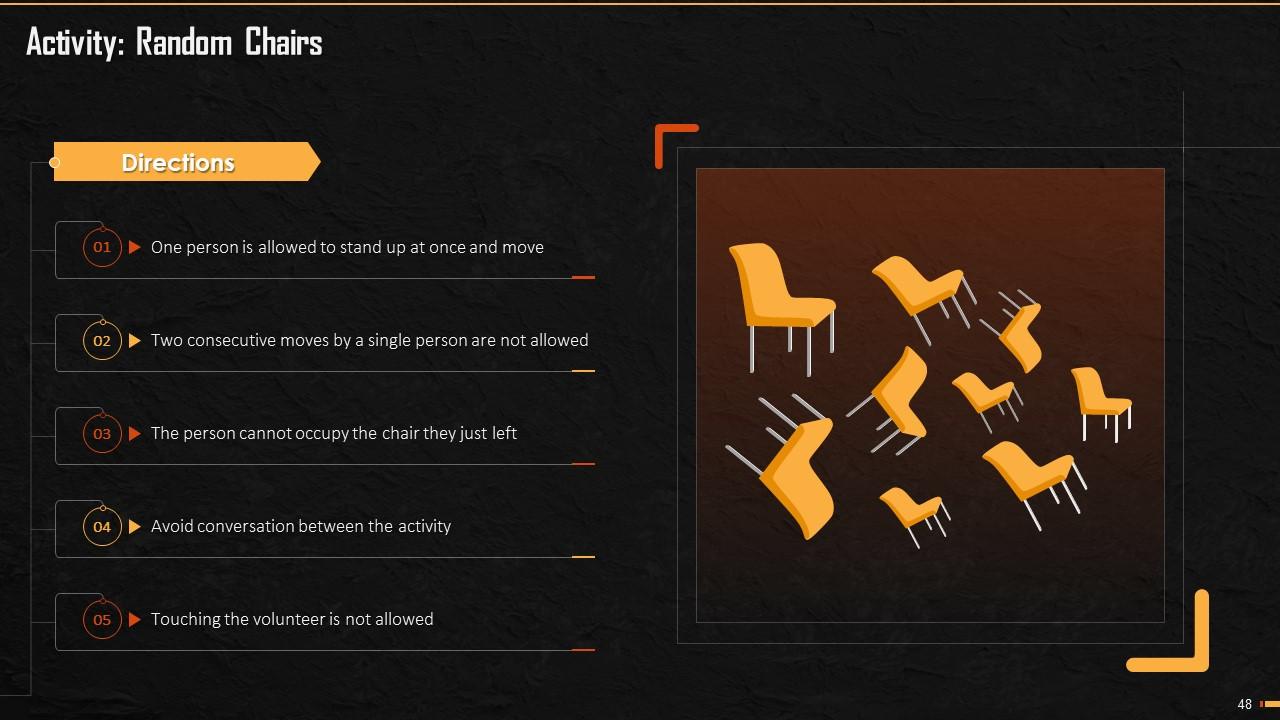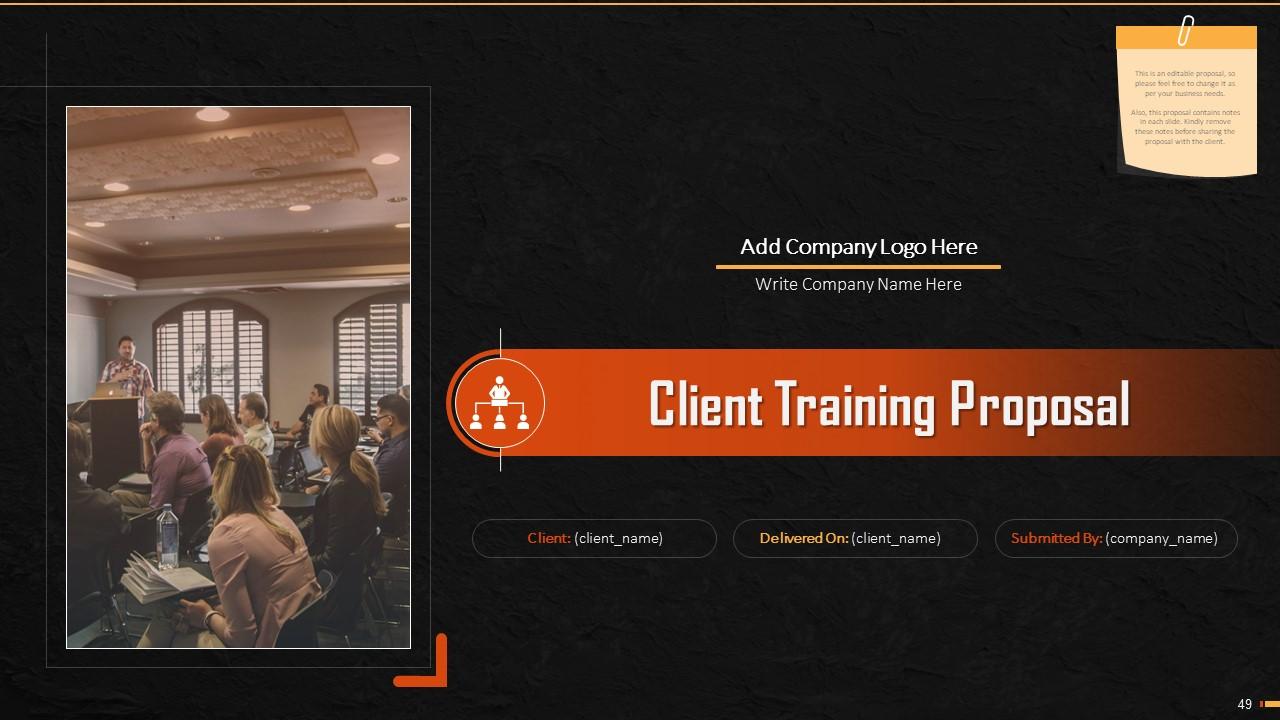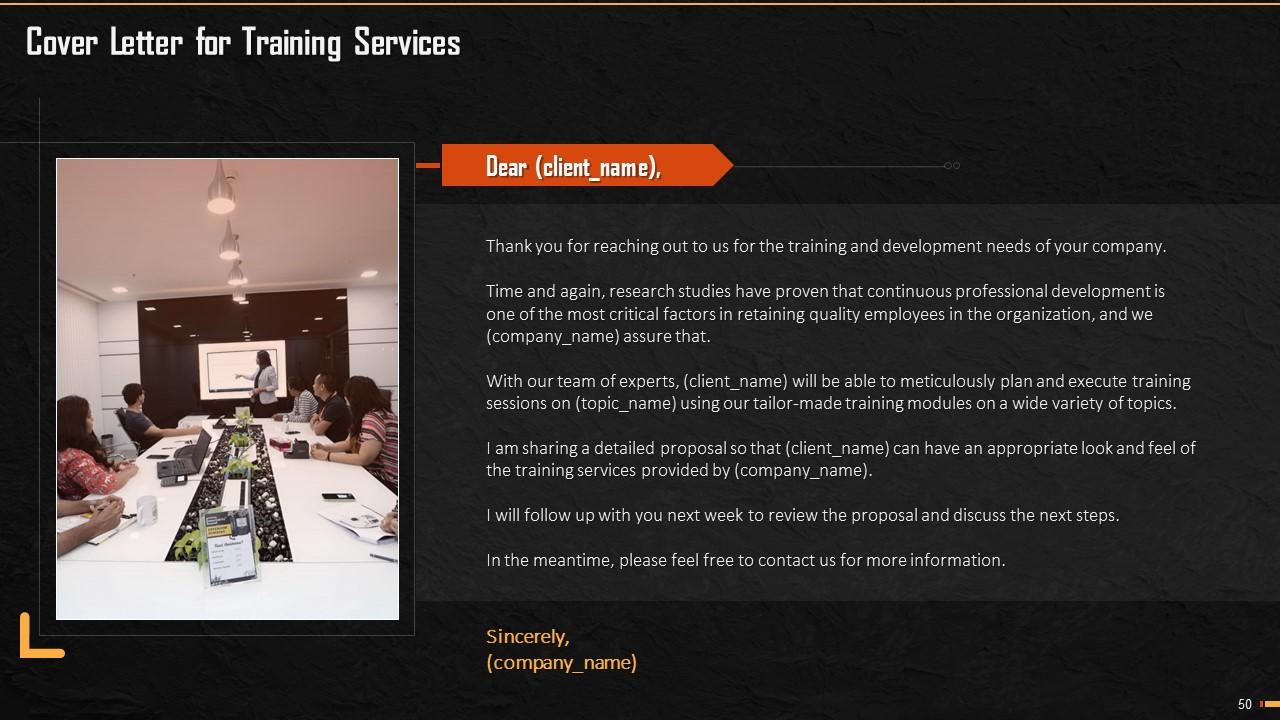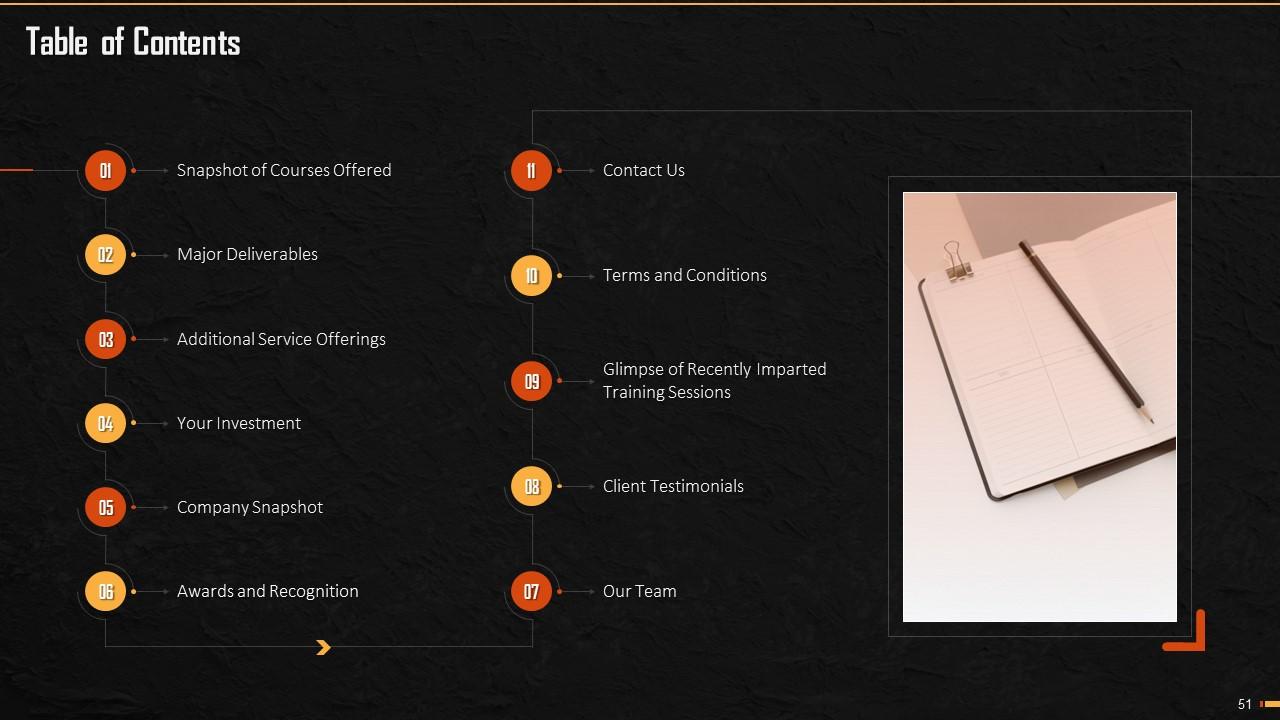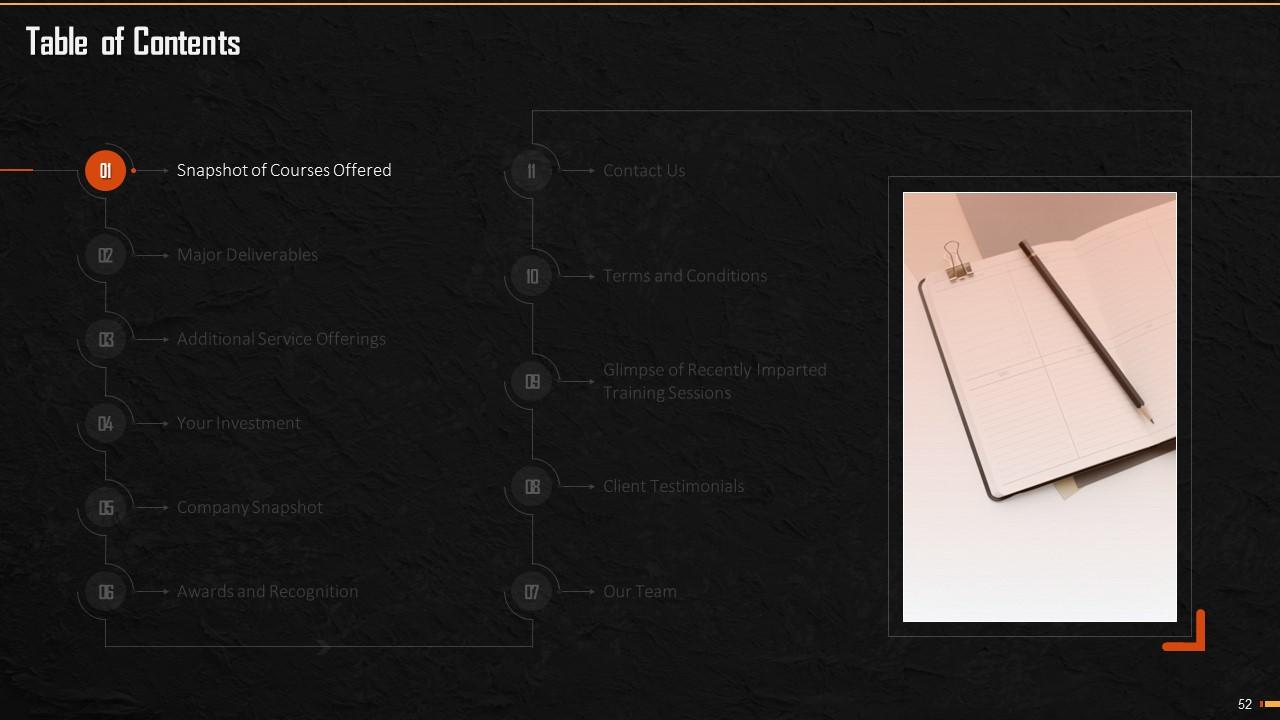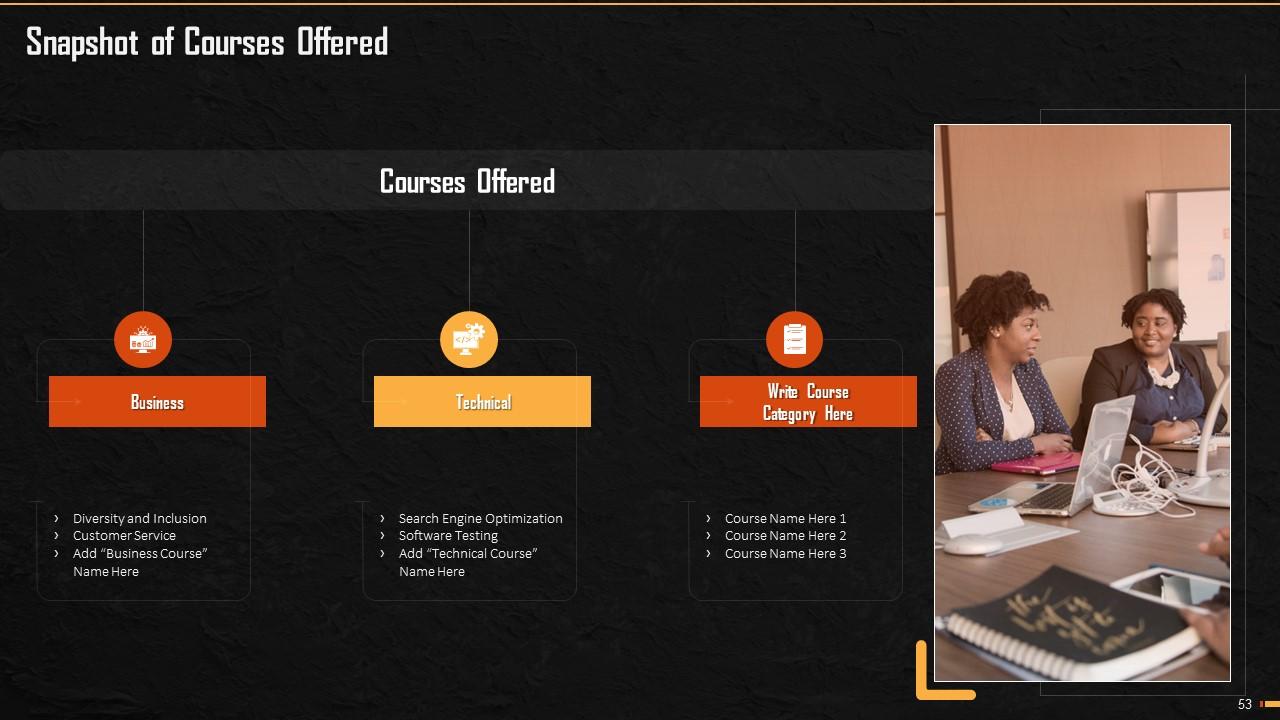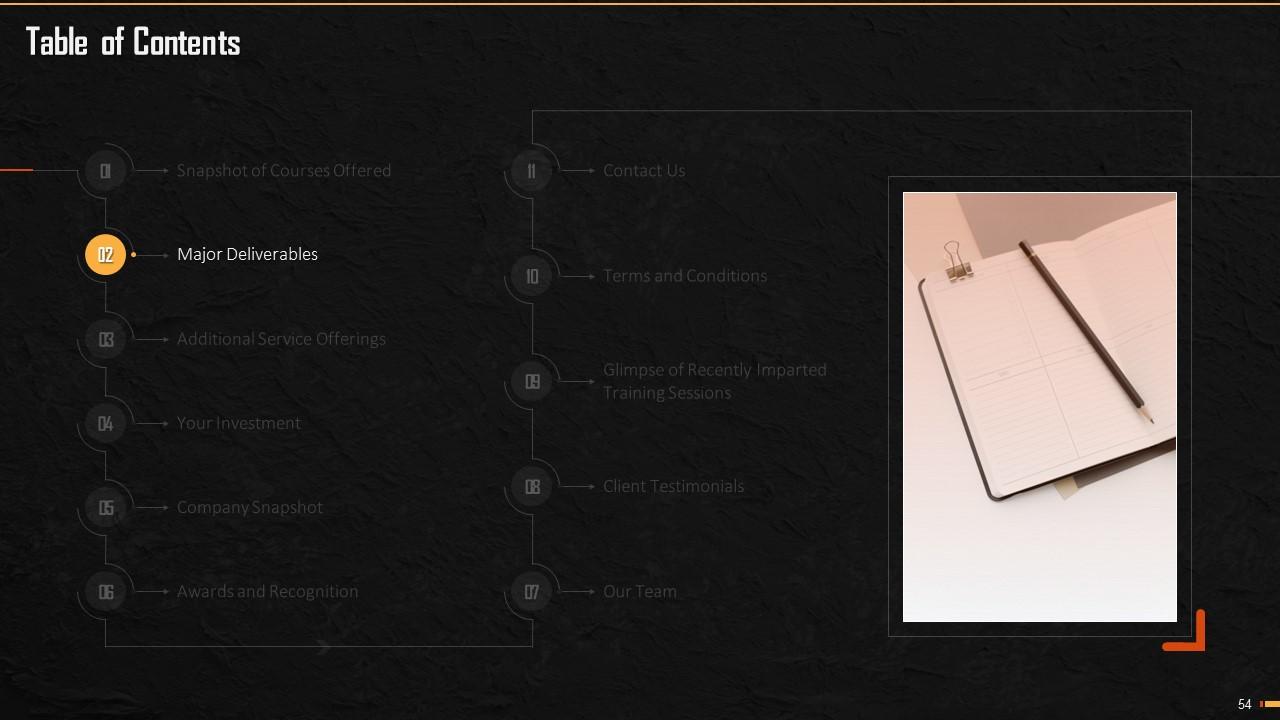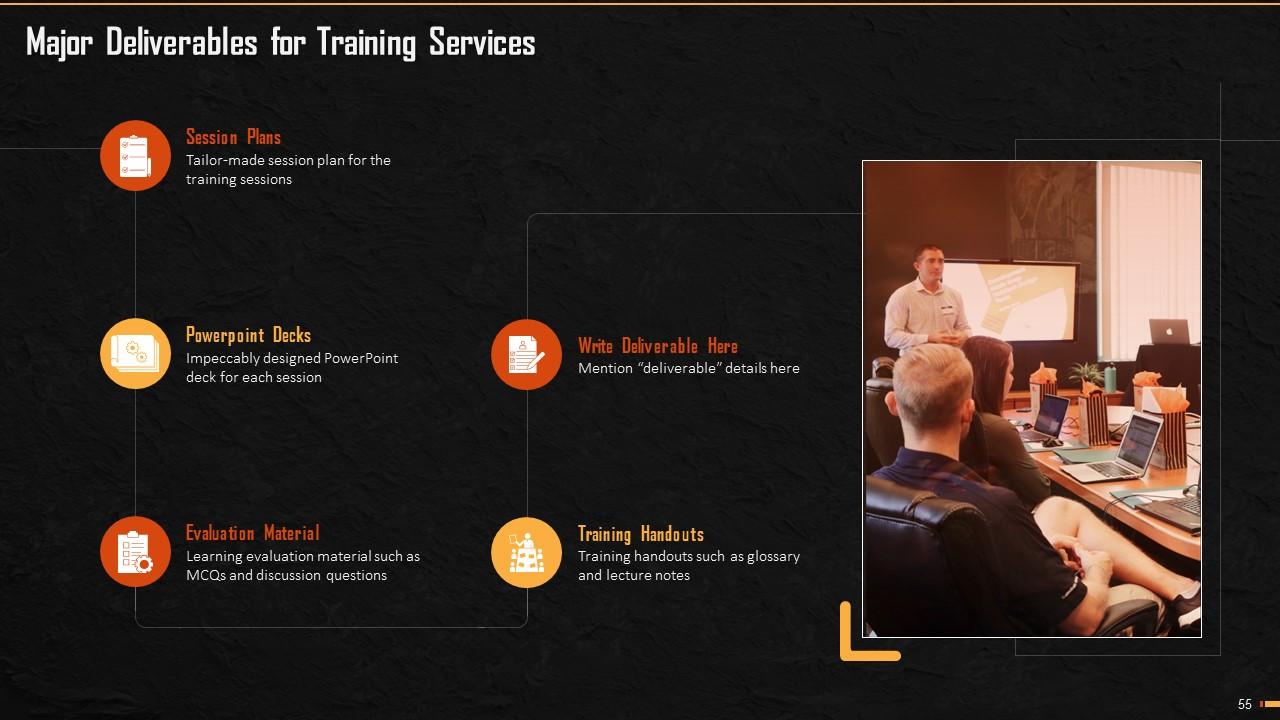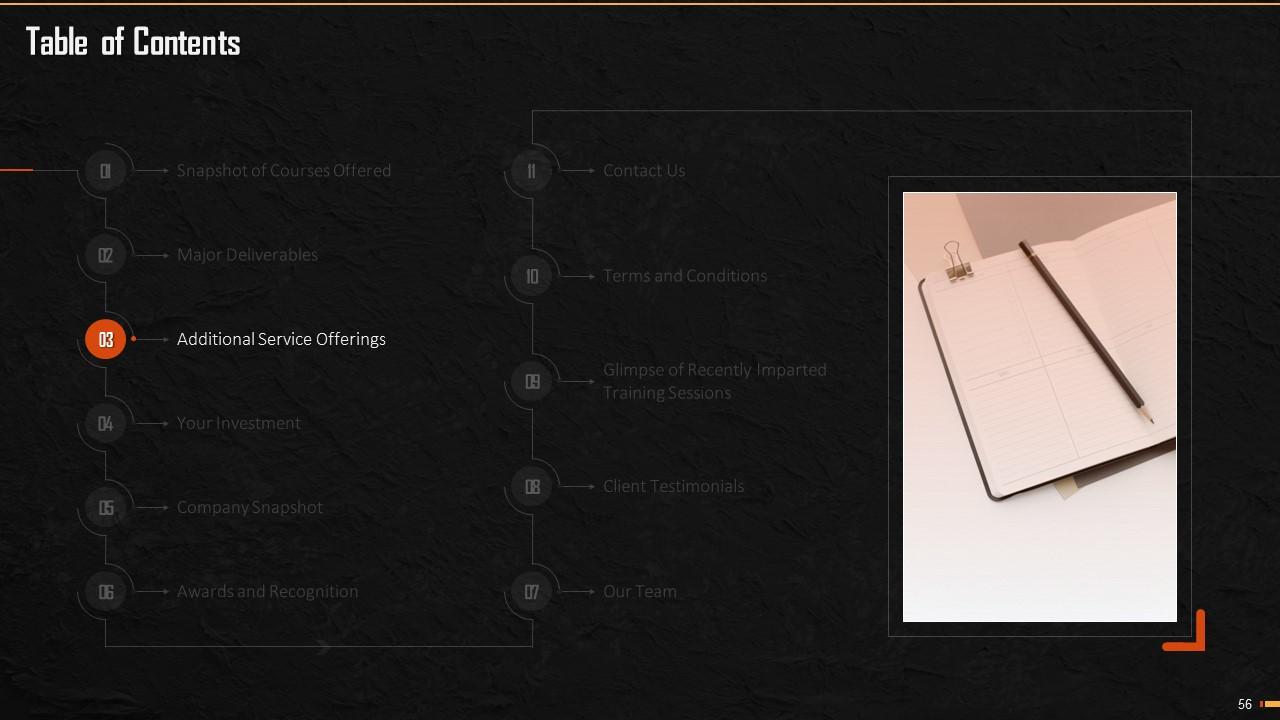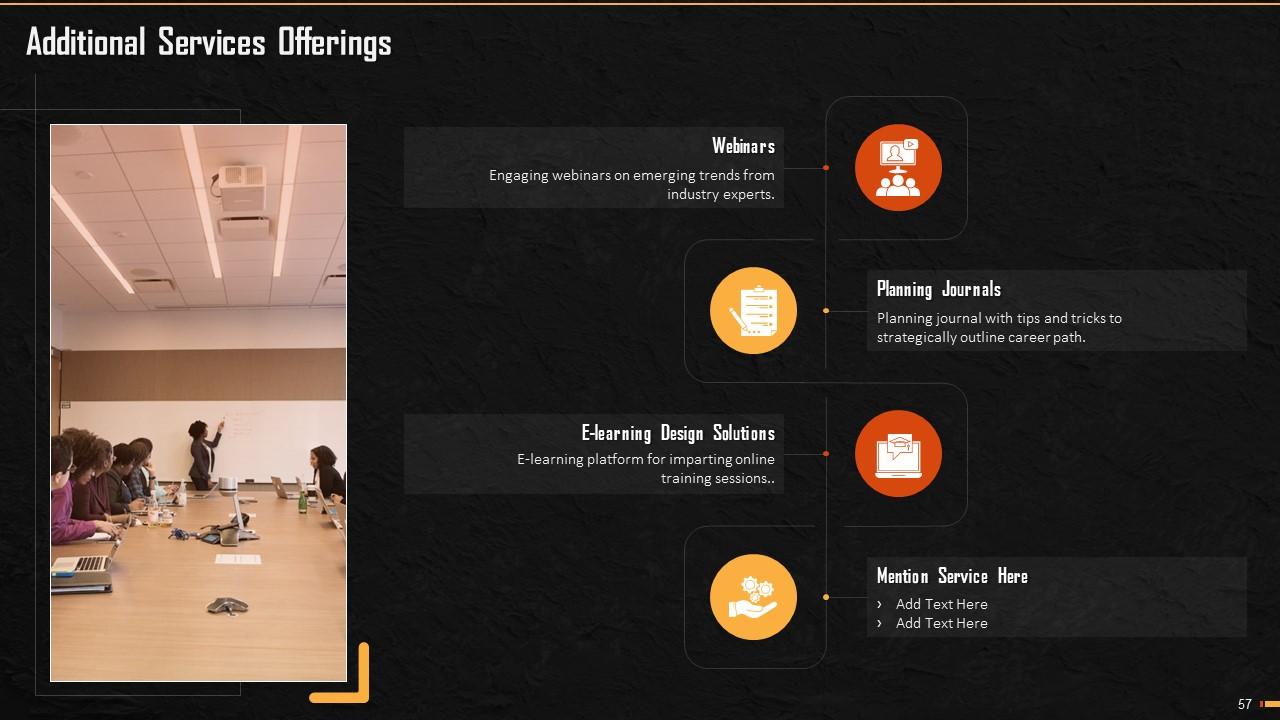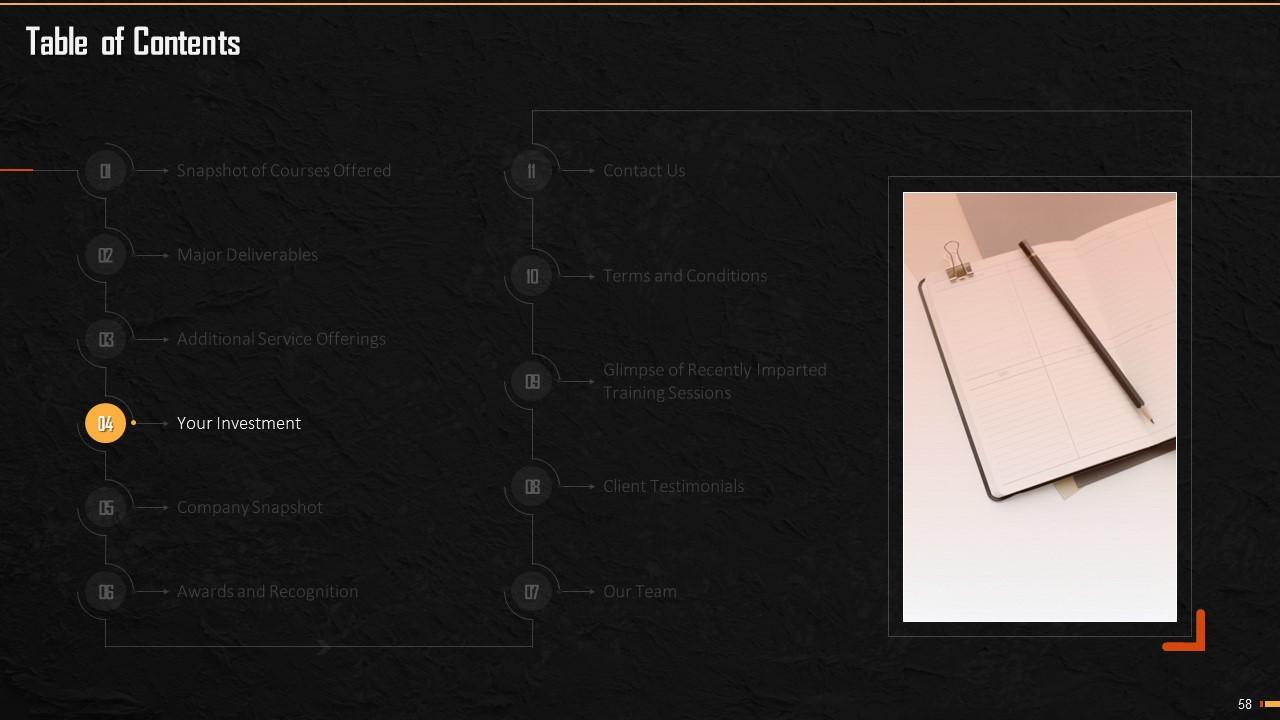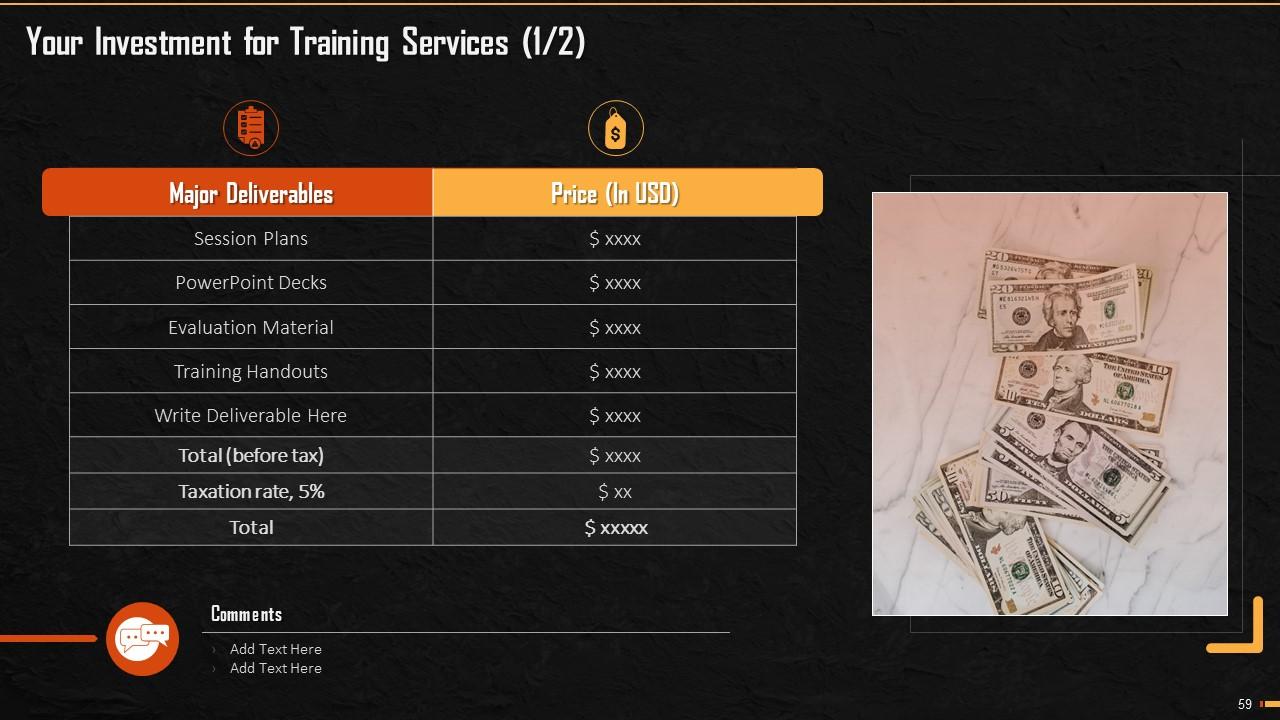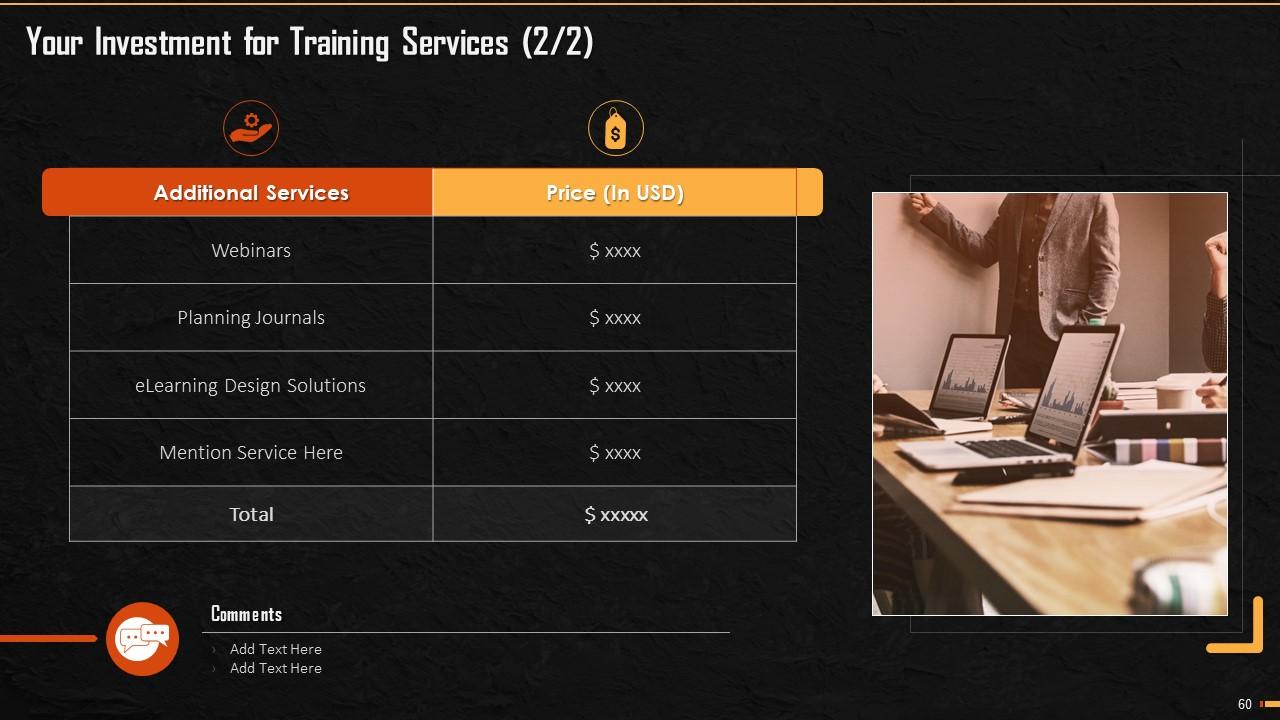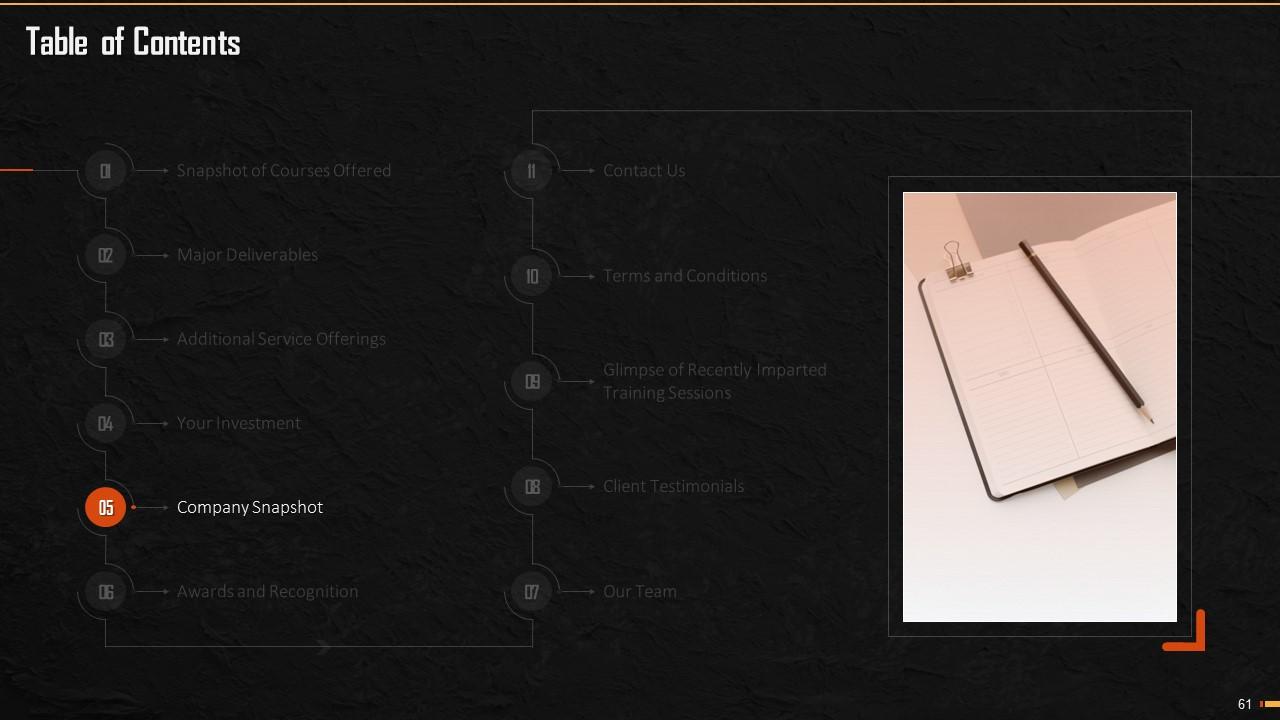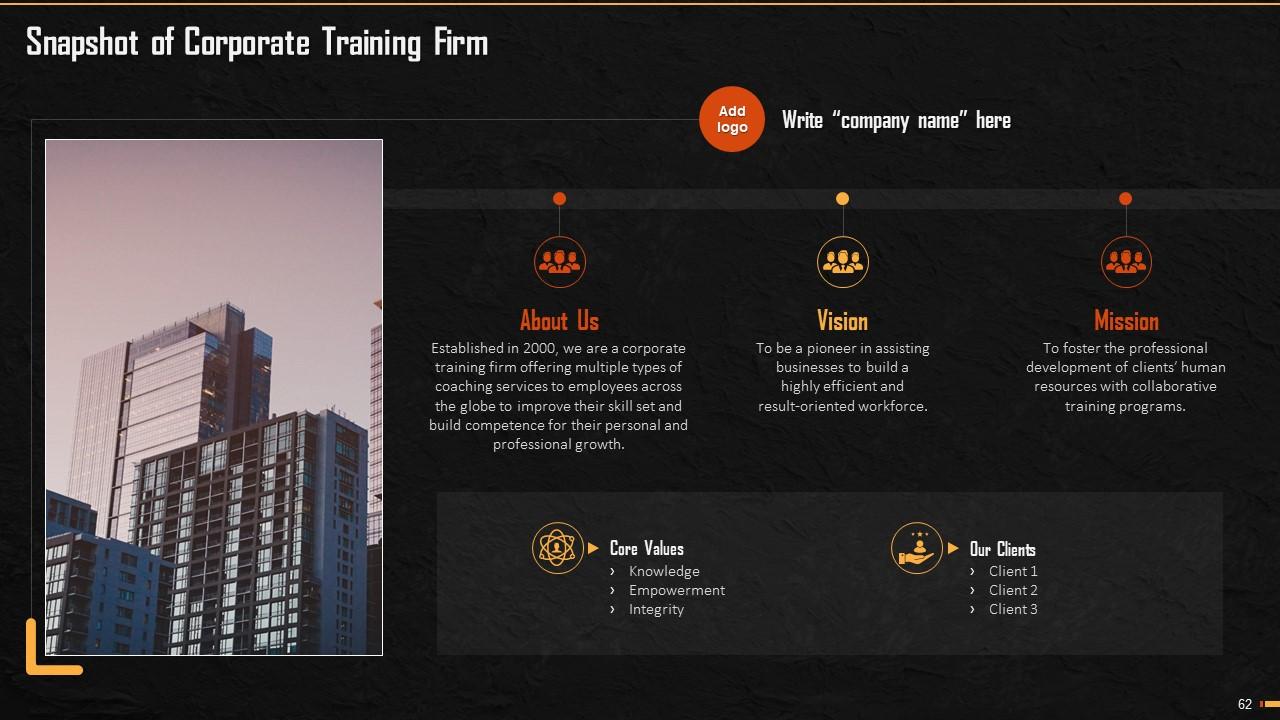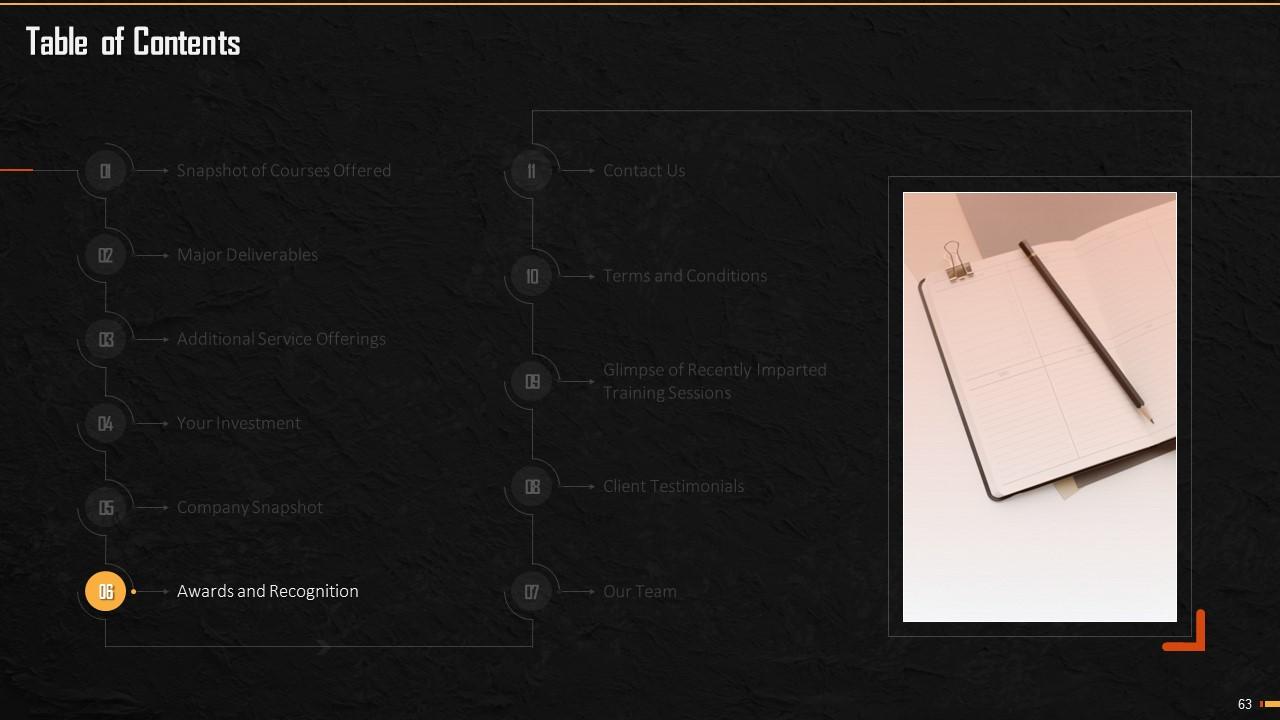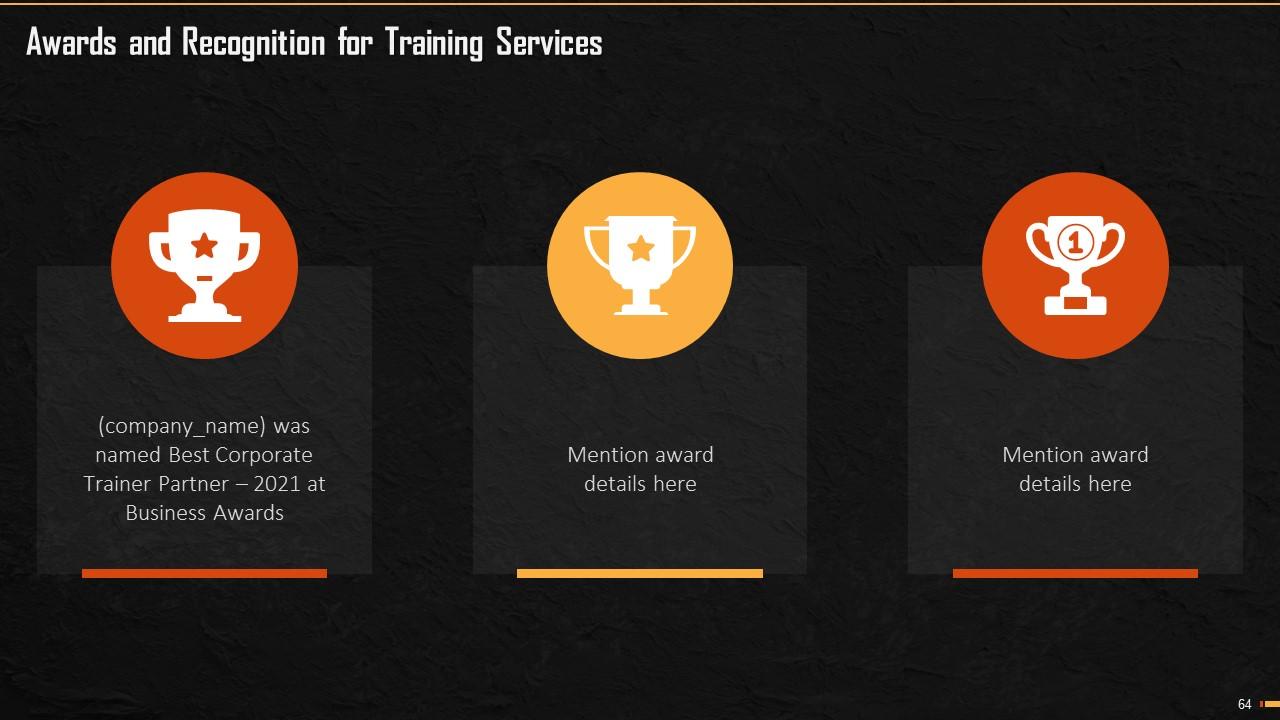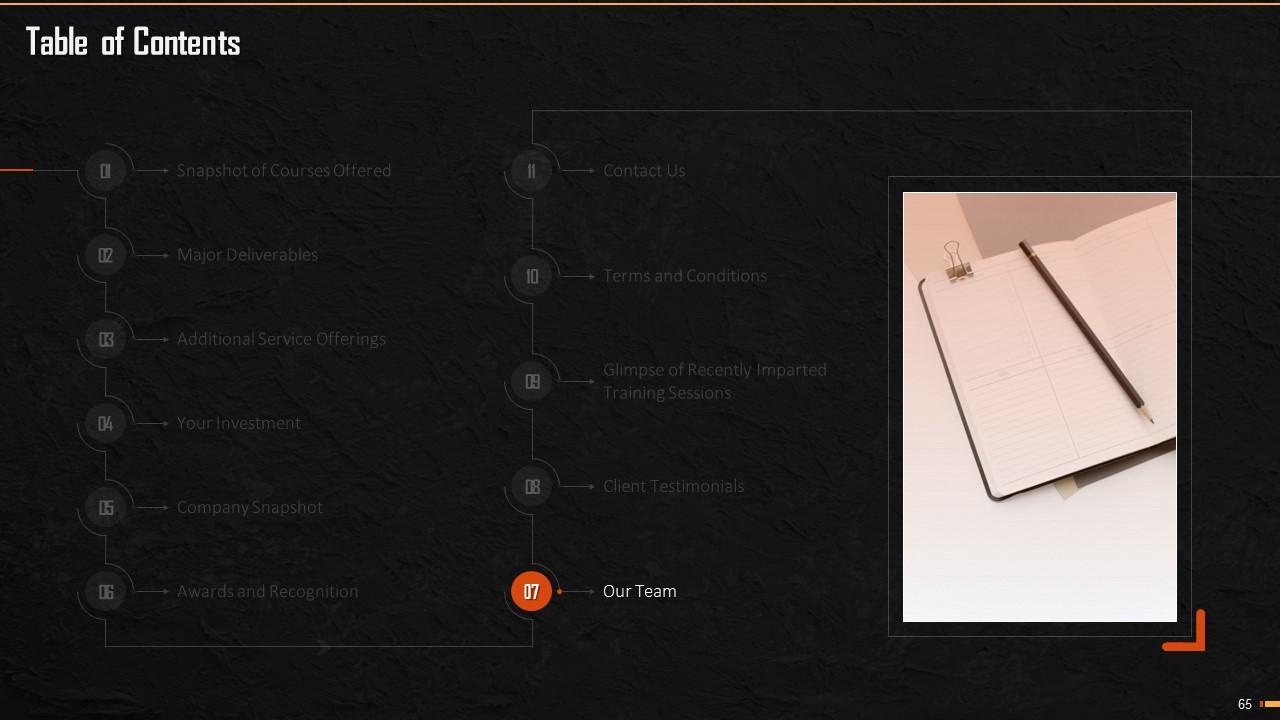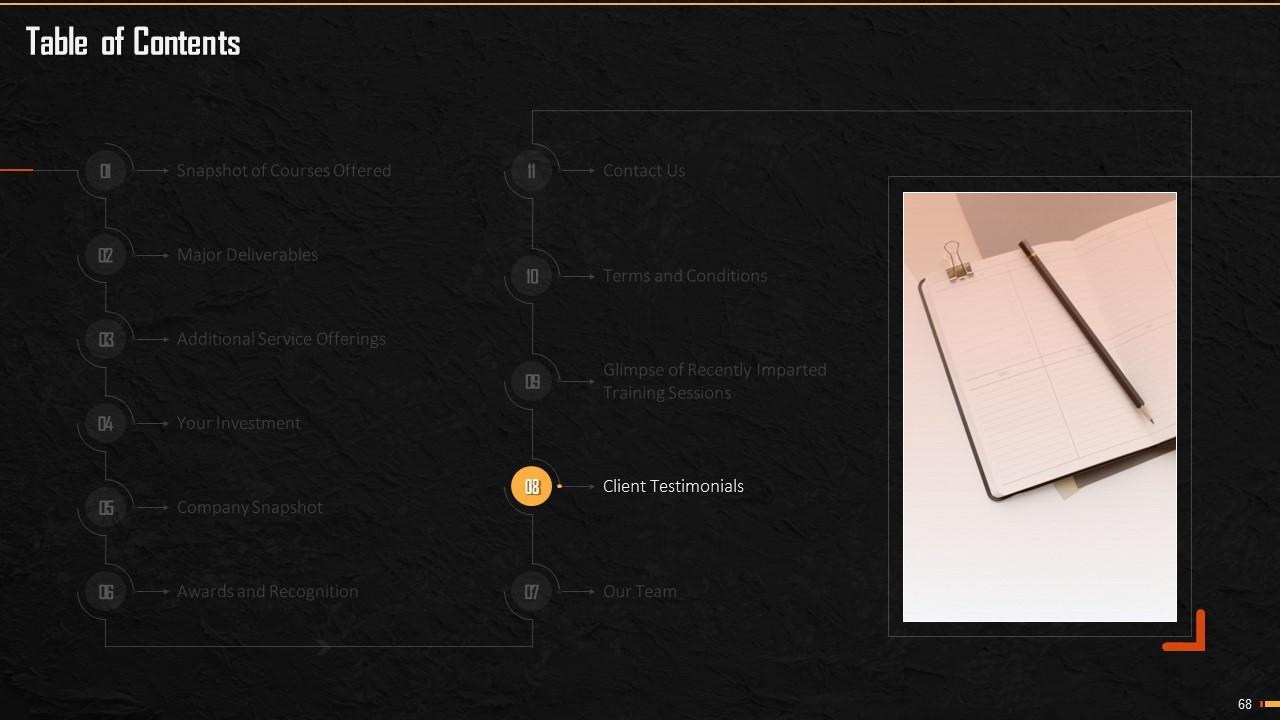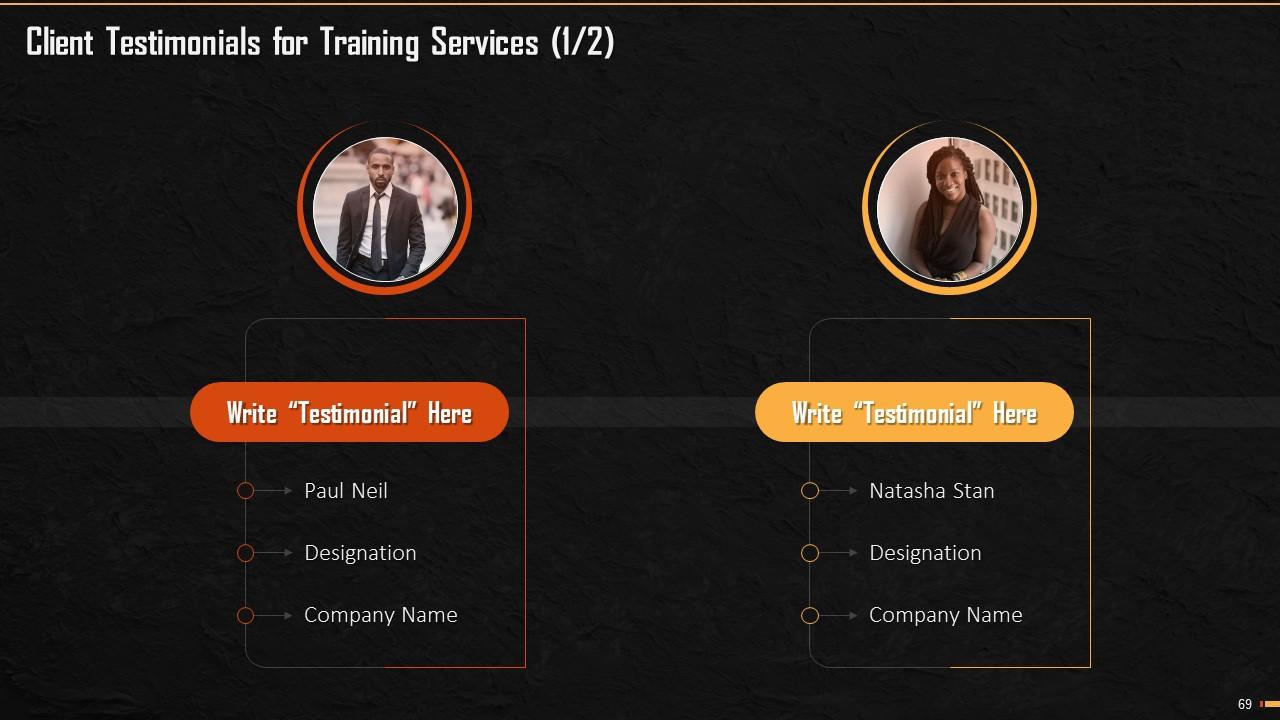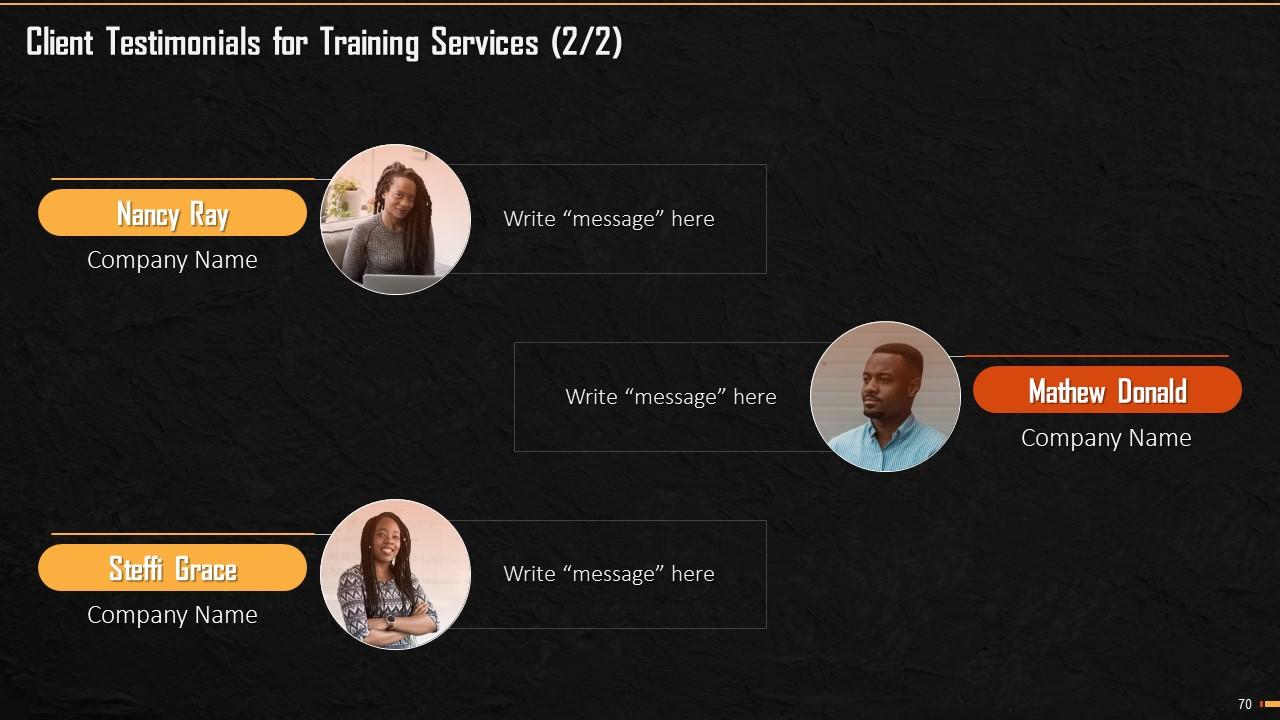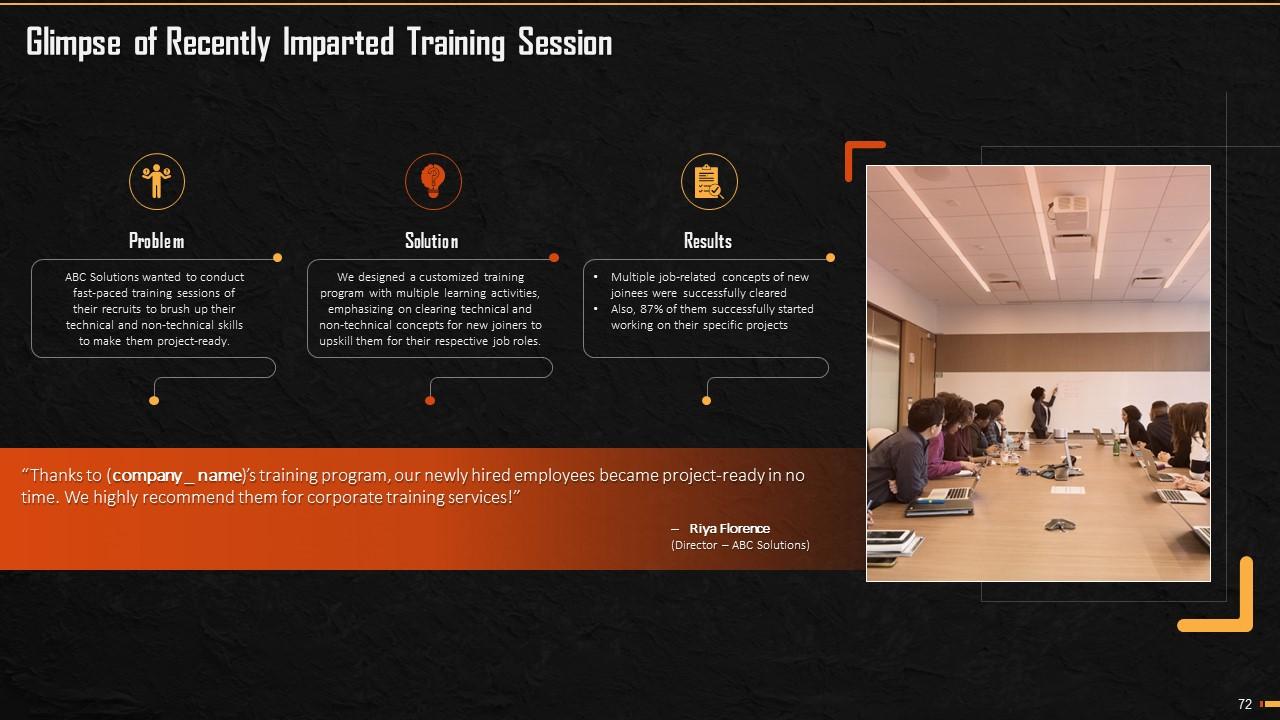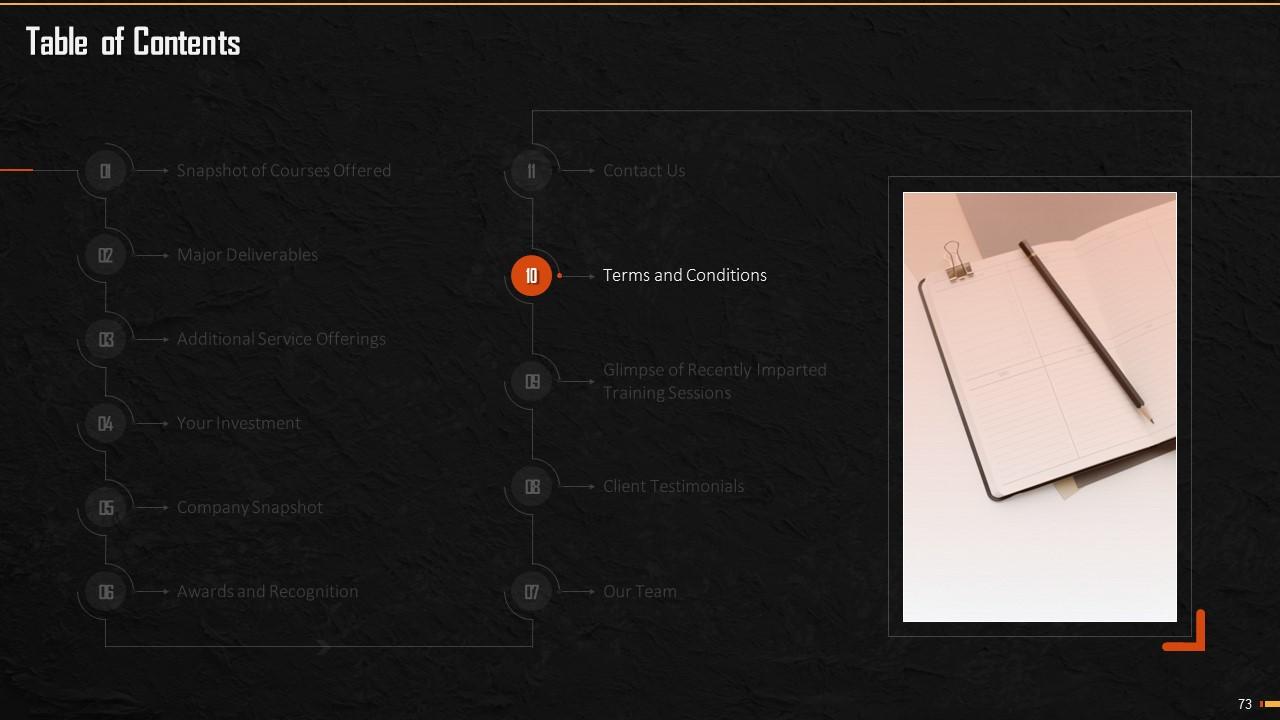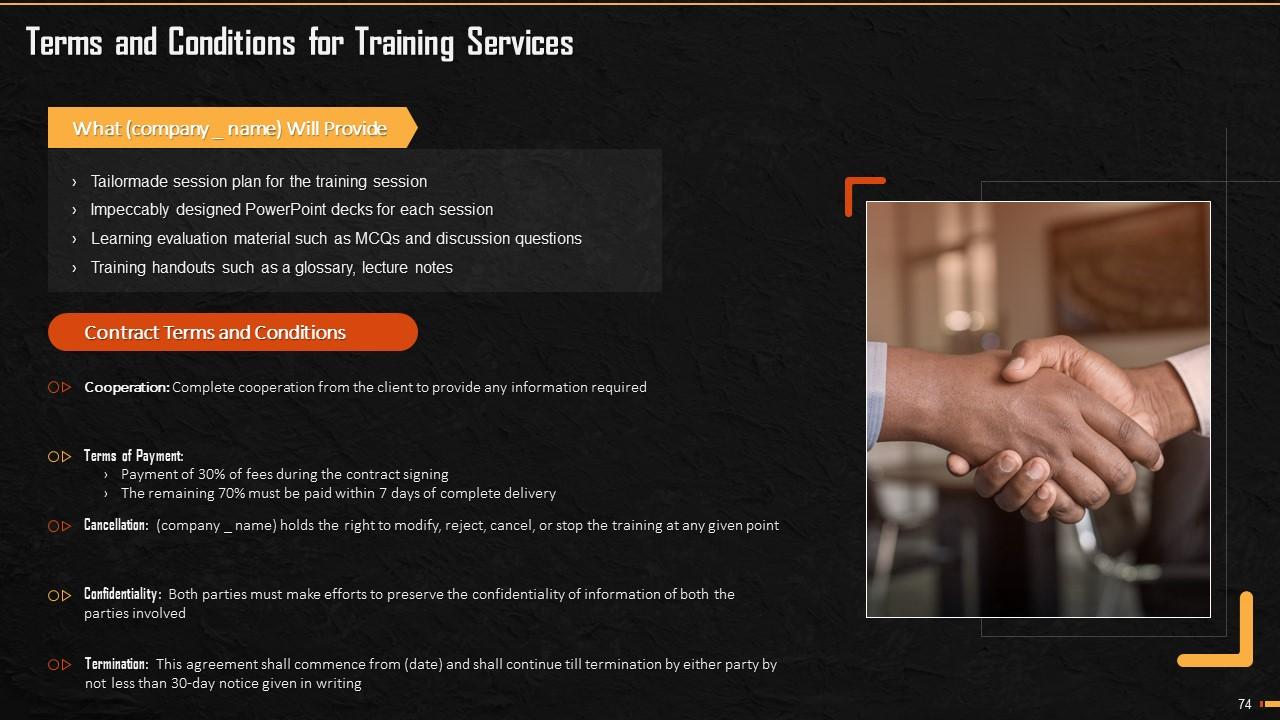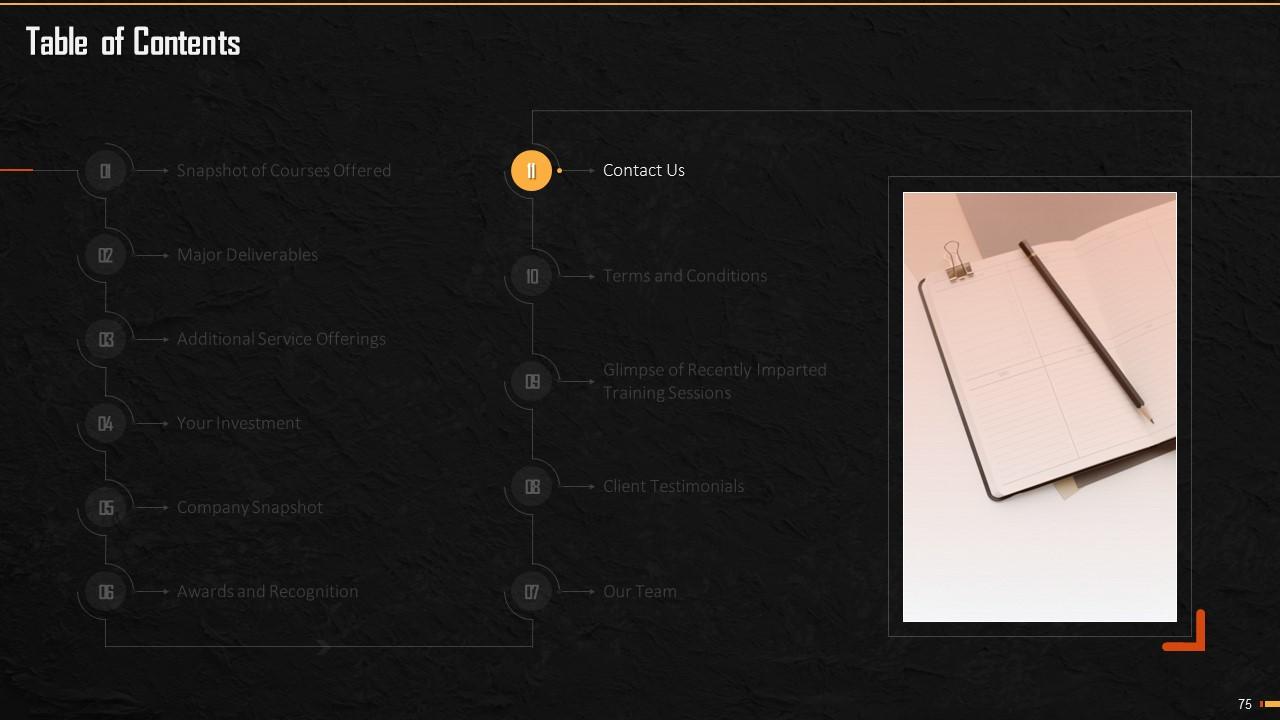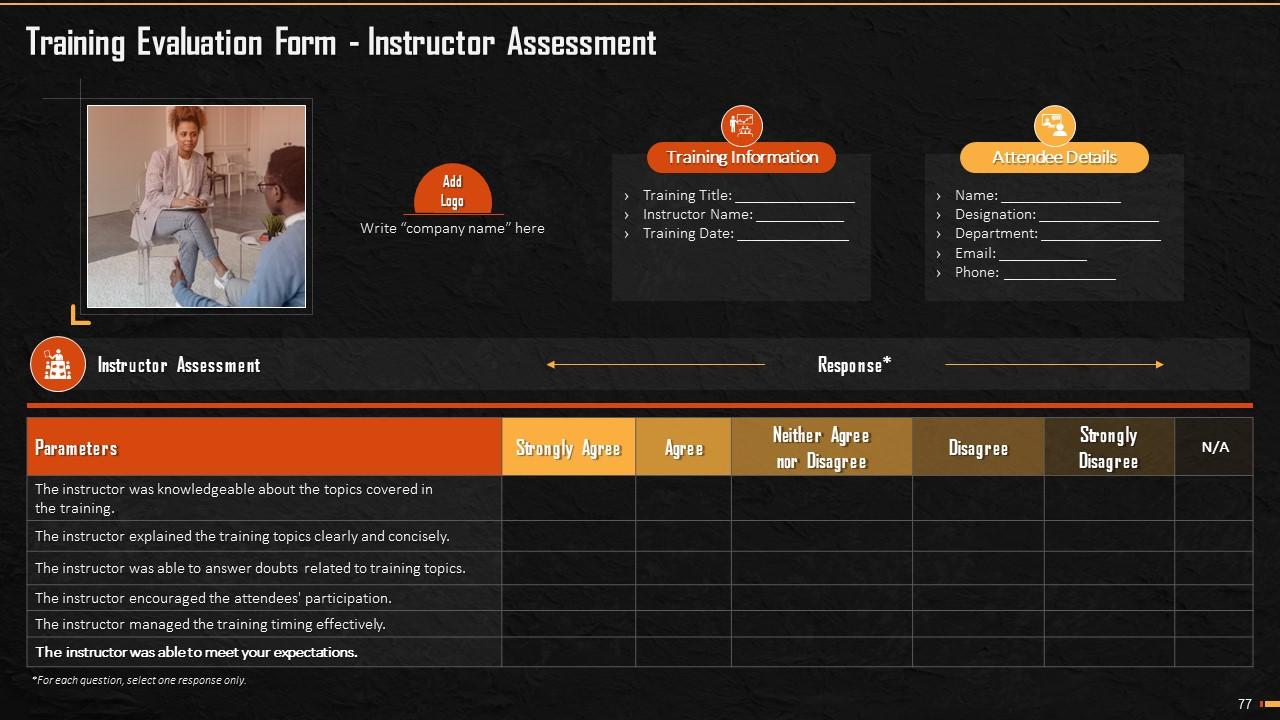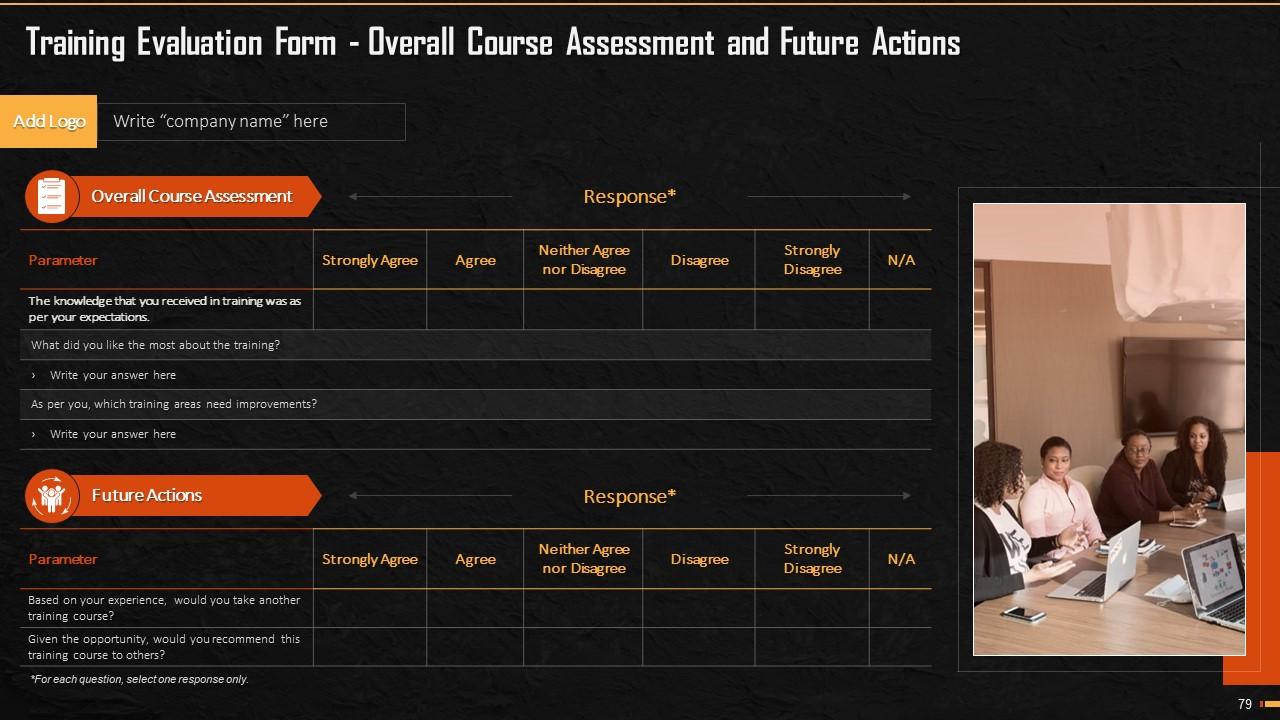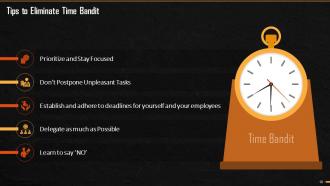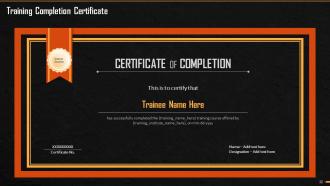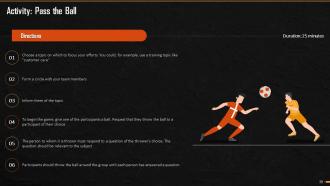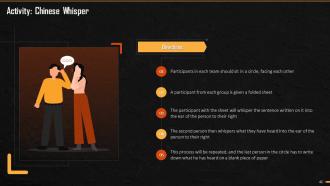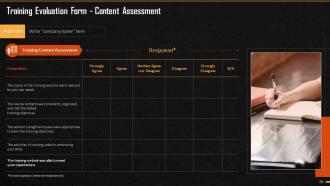Acknowledging Lack Of Time Management Training Ppt
This training module on Acknowledging Lack of Time Management contains questionnaires and activities to make the coaching session audience aware of their lack of time management skills. It covers the reason behind unconscious time wastage and its negative consequences. Further, it has time management statistics and examines ways to identify and eliminate time bandits. It has key takeaways and discussion questions related to the topic too. The deck has PPT slides on about us, vision, mission, goal, 30-60-90 days plan, timeline, roadmap, and training completion certificate. It contains energizer activities to engage the coaching session audience. It also includes a client proposal and assessment form for training evaluation.
- Google Slides is a new FREE Presentation software from Google.
- All our content is 100% compatible with Google Slides.
- Just download our designs, and upload them to Google Slides and they will work automatically.
- Amaze your audience with SlideTeam and Google Slides.
-
Want Changes to This PPT Slide? Check out our Presentation Design Services
- WideScreen Aspect ratio is becoming a very popular format. When you download this product, the downloaded ZIP will contain this product in both standard and widescreen format.
-

- Some older products that we have may only be in standard format, but they can easily be converted to widescreen.
- To do this, please open the SlideTeam product in Powerpoint, and go to
- Design ( On the top bar) -> Page Setup -> and select "On-screen Show (16:9)” in the drop down for "Slides Sized for".
- The slide or theme will change to widescreen, and all graphics will adjust automatically. You can similarly convert our content to any other desired screen aspect ratio.
Compatible With Google Slides

Get This In WideScreen
You must be logged in to download this presentation.
PowerPoint presentation slides
Presenting Training Deck on Acknowledging Lack of Time Management. This deck comprises of 79 slides. Each slide is well crafted and designed by our PowerPoint experts. This PPT presentation is thoroughly researched by the experts and every slide consists of an appropriate content. All slides are customizable. You can add or delete the content as per your need. Not just this, you can also make the required changes in the charts and graphs. Download this professionally designed business presentation, add your content and present it with confidence.
People who downloaded this PowerPoint presentation also viewed the following :
Content of this Powerpoint Presentation
Slide 5
This slide showcases a questionnaire on time management, prioritizing, and productivity.
Instructor’s Note:
- Kindly instruct participants to complete the questionnaire individually
- Request trainees to rate individual statements based on their own experiences
Slide 6
This slide showcases a questionnaire on time management, prioritizing, and productivity.
Instructor’s Notes:
After trainees have completed their responses, the trainer must conduct a discussion with them based on the results
Interpretation of Scores
- 65–70: You have exceptional time management abilities
- 58 to 64: You have excellent time management abilities
- 51 to 57: You manage your time reasonably well but occasionally feel overwhelmed
- 44–50: Your career is likely to be stressful and unsatisfying unless you begin to manage your time more effectively
- Less than 44: You need to improve your time management abilities
Slide 7
This slide depicts a time management questionnaire in which trainees are asked to write the aspect(s) of their time management that they would like to improve the most.
Instructor’s Notes:
- The instructor must request participants to write an individual response based on their own experiences
- Once everyone has answered, the trainer can have a discussion with the trainees based on the responses
Slide 8
This slide illustrates a time management questionnaire, on which the trainees will be asked to write the reasons for their poor time management and factors that worsen it.
Instructor’s Notes:
- The instructor should request trainees to write down the reasons for their poor time management
- Once the responses have been completed, trainees can discuss reasons
Slide 9
This slide depicts a time management questionnaire, on which trainees will be asked to rank the factors they need to strength the most to improve their time management skills.
Instructor’s Notes:
- The instructor will have trainees rate the situations based on their time management, prioritization, and productivity abilities
- Once the responses have been completed, trainees can discuss responses
Slide 10
This slide illustrates an activity named “How long is a Minute” that can be performed during the training session. The concept to be showcased is that people's perceptions of time differ from each other.
Instructor’s Notes:
How to Assess the Participants
- Keep track of how long the first 5/6 participants sat
- You can begin your discussion once everyone has sat down
- You'll notice that the participants open their eyes at different time periods
- Some participants consider one-minute short period, while others consider it a long time period
Lesson: This time management activity will give participants an idea of their perception, allowing them to calculate how long it will take them to complete a task or project. They will discover the relationship between time and productivity. With participants sitting down at different times, you can demonstrate how perception heavily influences time.
Slide 11
This slide depicts an activity named “What Did You Do Yesterday” that can be performed during the training session.
Instructor’s Notes:
- It is preferable for participants to complete this task individually first and then discuss it in pairs
- Allow trainees five minutes to write down their five accomplishments and one wasteful thing
- Request participants to discuss and compare their lists with the person sitting next to them
Outcome: Discussing their achievements will make participants feel good because it will focus on what they accomplished with their time. We frequently beat ourselves up because we believe we have done nothing when, in fact, we have done far more than we give ourselves credit for. Focusing on one wasteful task, on the other hand, will start a conversation about what an unproductive activity is and how to avoid time-wasters.Some participants consider one minute short period, while others consider it a long time period
Lesson: This time management activity will give participants an idea of their perception, allowing them to calculate how long it will take them to complete a task or project. They will discover the relationship between time and productivity. With participants sitting down at different times, you can demonstrate how perception heavily influences time.
Slide 12
This slide explains ways people unconsciously waste time. Some of these are small task addiction, unnecessary meetings, procrastinating and procrastinating, working on the wrong priorities, multitasking, doing other people’s work, etc.
Instructor’s Notes:
Ways People Unconsciously Waste Time
- Small Task Addiction: Completion bias affects many of us. It feels good to complete a task, prioritizing work that we can easily delegate. However, prioritizing small tasks may result in deferring more "meaningful" complex tasks that provide us with a sense of accomplishment and purpose
- Unnecessary Meetings: People probably don't need to attend a meeting if they don't contribute or learn anything new. Meetings are necessary, but they are overused in far too many workplaces. It's one of the most time intensive forms of business communication available, especially when you consider the preparation, potential delays and overrun time and post-meeting emails
- Procrastinating and Precrastinating: The act of postponing decisions or actions unnecessarily is known as procrastination. It is typically caused by a person's inability to self-regulate behavior. Procrastination is generally unintentional and irrational, which means that people procrastinate even when they know it is bad for them and want to stop. Rushing into tasks too quickly, often wasting time and effort that could have been saved, is known as "precrastination."
- Working on the Wrong Priorities: People are not making the best use of their time unless they work on their most important tasks. Many of us waste time due to poor prioritization, working on tasks that make us feel busy but do not help us progress
- Multitasking: Diverting attention between too many tasks at once can also reduce net productivity. Context switching has a cognitive cost, and it takes time to refocus each time you switch to another task, lowering the quality of thinking
- Doing Other People’s Work: While delegation and support are essential for effective team collaboration, one should not do someone else's work as a matter of routine. It is a waste of time if a task does not serve its own goals and responsibilities
- Passive Work: Time spent in knee-jerk responses to emails, messages, and phone calls makes us feel busy. Still, we aren't necessarily moving important work forward, and these passive, often unforeseen tasks don't lend themselves easily to a measurement of "progress."
Slide 13
This slide depicts effects of failing to manage time in an effective manner. The consequences include lack of focus and prioritization, missed deadlines, poor work quality, wasted time, and poor working relationships.
Instructor’s Notes:
Effects of Neglecting Time Management
- Lack of Focus and Prioritization: People frequently have more on their to-do lists than they can complete in a day or week. Employees who cannot effectively use time often feel overwhelmed and focus only on what is most urgent at the time
- Missed Deadlines: If people do not manage their time well, they are more likely to miss deadlines, lowering the performance in their role
- Poor Quality of Work: When rushing to complete tasks, people almost always sacrifice quality for speed. They can avoid this by allowing themself enough time at the end of each day to double-check for errors and make any necessary changes
- Wasted Time: Starting any tasks or projects with unclear priorities will result in inefficient workflow and low productivity. People get distracted when they do not understand what is expected of them. This initial step toward procrastination will result in doing unfocused work, which only contributes to the company wasting opportunities
- Poor Working Relationships: Poor time management, for example, may have a negative impact on others if someone is late for a meeting. To avoid such situations, one must carefully plan their schedule. Even if you don't think you'll need it, always leave enough time to correct your work. Arriving early is preferable to arriving late
Slide 15
This slide illustrates the key statistics on time management, multitasking, time audit etc. It highlights how people waste their time and are unaware of the concept of time management itself.
Slide 16
This slide depicts statistics on how employees manage their time, challenges faced by businesses while tracking productivity, and common employee distractions.
Slide 17
This slide depicts information about Time Bandits. It explains how time bandits prevent employees from efficient completion of tasks. The most common workplace distractions harm overall productivity, and interruptions deplete an employee's momentum, making it difficult to return to work once he/she has been distracted. Some workplace bandits are unproductive meetings, interruptions, electronic communication, and personal time use.
Instructor’s Notes:
Following are the workplace time bandits
- Unproductive Meetings: Meetings enable colleagues to share information and brainstorm, but these are not always necessary. Regular meetings for the sake of having them aren't always the best use of staff time. Only convene meetings that will be beneficial.
- Interruptions: A typical office environment sees numerous interruptions from colleagues and clients. These interruptions affect an employee's concentration and force him/her to stop working. An employee who does not know how to manage interruptions and prioritize his constantly changing workload will accomplish little during the day. Employees who receive training on how to deal with the demands of job is better equipped to deal with
- Electronic Communication: Communication, via instant messaging and email, has become a common practice in the business world. For example, coworkers in the same building may even discuss work-related issues online rather than in person. While electronic communication is generally efficient, it can rob employees of work time if they become too preoccupied with reading and responding to messages right away. Stopping to read a message whenever a notification appears disrupts workflow. Employees tend to shifts focus to another project, putting the original project on hold
- Personal Time Use: Personal issues also consume time at work. In many offices, personal internet use eats into work time. Employee may quickly search for personal information only to become entangled in additional searches. They may be clueless about how much time they waste at work on personal emails, phone calls, and web browsing. Create policies that address personal time at work and emphasize the importance of dealing with personal matters during breaks
Slide 18
This slide demonstrates how to eliminate time bandits. The tips are: Prioritize and focus, don't put off unpleasant tasks, set and stick to deadlines for yourself and your employees, delegate as much as possible, and learn to say no.
Slide 19
This slide demonstrates an activity named “Identifying Time Bandits” on Time Management to be performed during training session.
Instructor’s Notes:
Some Common Time Bandits are:
- Texting
- Being disorganized
- Surfing web endlessly
- Gossiping
- Lack of Focus
- Hanging out endlessly
- Procrastinating
- Flitting from one activity to another
- The activity needs to be conducted in groups
- Dictate the following common time bandits to the trainees
- Allow anyone who has a particularly intense time bandit and wants to share a second turn
- Once all members have had their turn. Discuss among the groups – are there times or days of the week that are more vulnerable to time bandits?
Slide 20
This slide demonstrates key takeaways from the session acknowledging lack of time management.
Slide 21
This slide demonstrates discussion questions from the session acknowledging lack of time management.
Slide 33 to 48
These slides depict energizer activities to engage the audience of the training session.
Slide 49 to 76
These slides consist of a client training proposal highlighting what the company providing corporate training can accomplish for the client.
Slide 77 to 79
These slides highlight the training evaluation form for instructor, content, and course assessment.
Acknowledging Lack Of Time Management Training Ppt with all 84 slides:
Use our Acknowledging Lack Of Time Management Training Ppt to effectively help you save your valuable time. They are readymade to fit into any presentation structure.
-
Loved the templates on SlideTeam, I believe I have found the go to place for my presentation needs!
-
SlideTeam’s readymade presentations have landed my unique images with my bosses in the past and it continues to reward me.



